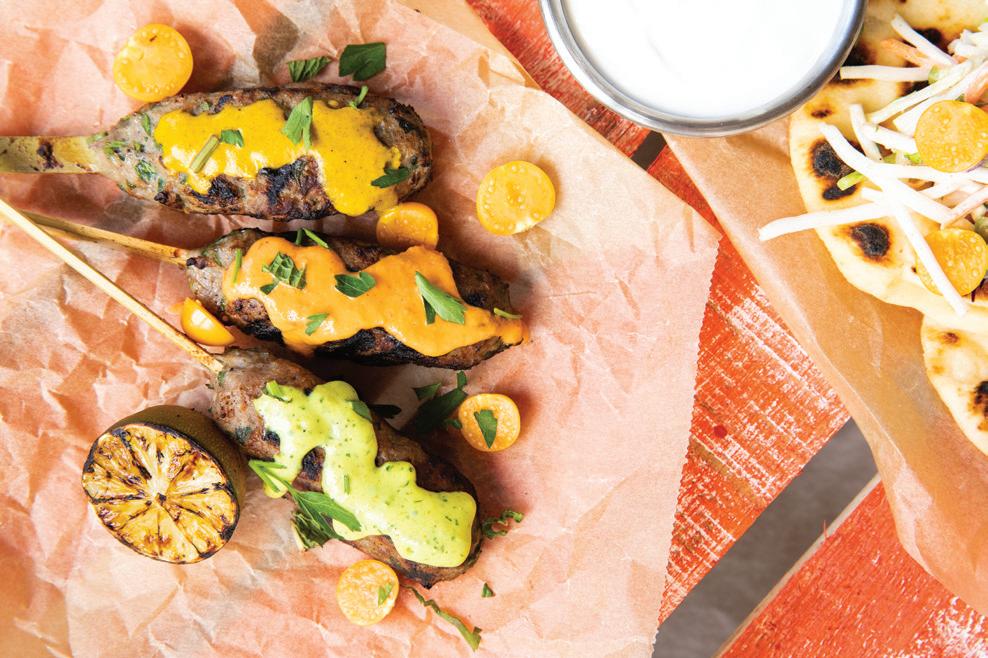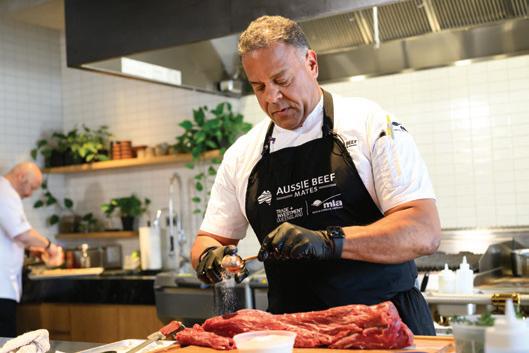

MELLOW MUSHROOM’S RADICAL RISE
CEO RICHARD BRASCH IS LEADING THE 170UNIT PIZZA BRAND INTO ITS NEXT ERA WHILE STAYING TRUE TO ITS ROOTS

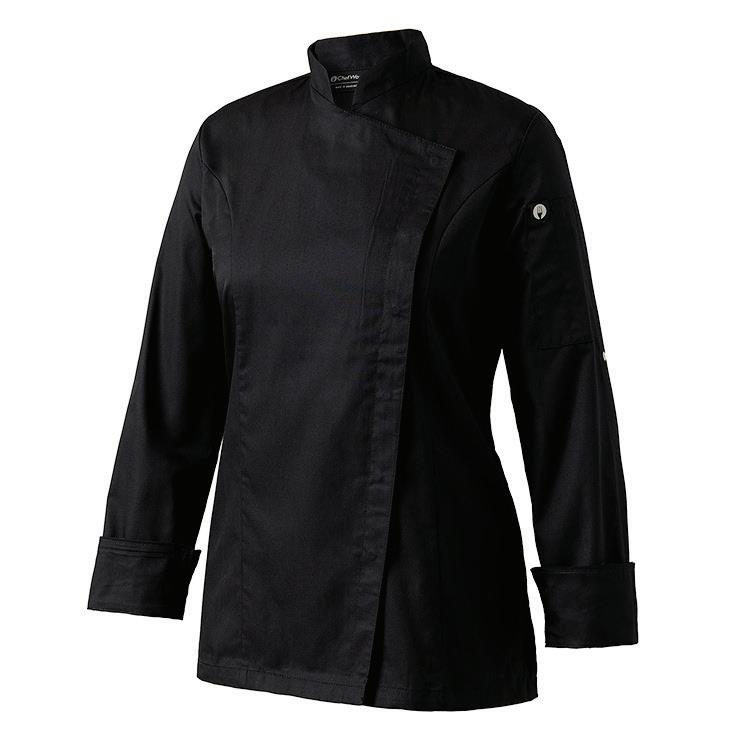

MELLOW MUSHROOM’S RADICAL RISE
CEO RICHARD BRASCH IS LEADING THE 170UNIT PIZZA BRAND INTO ITS NEXT ERA WHILE STAYING TRUE TO ITS ROOTS



WITH 170 LOCATIONS, CEO
RICHARD BRASCH IS LEADING MELLOW MUSHROOM INTO ITS NEXT ERA WHILE STAYING TRUE TO ITS FUN, PSYCHEDELIC ROOTS.

26 The NextGen 25 + Mellow Mushroom’s Magical Rise
From one location to over 100, these 25 NextGen Casual restaurant brands are ones to watch as they raise hospitality standards and showcase how to grow with people-first cultures and great food at the center—with Mellow Mushroom leading the pack.
CHEFS & INGREDIENTS
11
Plating With a Purpose
Chef de cuisine at Miami’s Michelin-starred Tambourine Room by Tristan Brandt, 23-yearold Logan McNeil has a bold vision for the future of ethically sourced, fine-dining cuisine that keeps storytelling at the heart.

16
The New Language of Dessert
The final course has become a canvas for storytelling, blending memory, artistry, and innovation. Featuring insights from leaders at Uchi, Amal, Tai Er, The Brasserie, and The Ritz-Carlton Cleveland.
LIQUID INTELLIGENCE
21
Show-Stopping Sips
Whether it’s a $22 smoked cocktail or a daiquiri tree, drinks are getting bigger, bolder—and more profitable. Beverage leaders at Party Fowl, COJE, Thompson Restaurants, and more are using spectacle and storytelling to drive premiumization.


FIRST COURSE
7 Olive Garden Tests Smaller Portions
Early results show higher affordability scores and guest satisfaction, with potential expansion across Darden’s portfolio.
8 Where Are the Most Affordable Cities to Dine Out?
A new study compared restaurant costs against local wages across 177 cities worldwide to shed light on dining out affordability.
BACK OF HOUSE
41 Growing Through the Generations With Grumpy’s
WOMEN IN LEADERSHIP After nearly three decades, the “Queen of Grumpy’s” Margie Murphy passes the torch to the brand’s next generation of leaders, proving the company’s culture is the key to its staying power.
43 Elm Street Diner’s Recipe for Viral Success
ON THE RISE The growing brunch haven has amassed nearly 700k followers across social media with its viral stacked waffle towers and loaded pancake tacos—but it hasn’t sacrificed quality along the way.
46
Embodying Everyday Excellence
BEHIND THE SCENES Burtons
Grill & Bar CEO John Haggai shares how “everyday excellence” fuels consistency across the brand’s 20-plus locations; how their recent refresh is deepening guest relationships; and why team development remains the heartbeat of his long-term vision.
ALSO IN THIS ISSUE
4 Editor’s Welcome 45 Advertising Index
LLC, 1111 Superior Avenue Suite 1120, Cleveland, OH 44114. Periodicals postage paid at Cleveland, OH and at additional mailing offices.
POSTMASTER: Send address changes to FSR, 101 Europa Drive, Suite 140, Chapel Hill, NC 27517-2380.
EDITORIAL
VP, EDITORIAL DIRECTOR: FOOD, RETAIL, & HOSPITALITY Danny Klein dklein@wtwhmedia.com
FSR EDITOR Callie Evergreen cevergreen@wtwhmedia.com
QSR EDITOR Ben Coley bcoley@wtwhmedia.com
ASSOCIATE EDITOR Sam Danley sdanley@wtwhmedia.com
ASSOCIATE EDITOR Satyne Doner sdoner@wtwhmedia.com
SVP, AUDIENCE GROWTH Greg Sanders gsanders@wtwhmedia.com
CONTENT STUDIO
VP, CONTENT STUDIO Peggy Carouthers pcarouthers@wtwhmedia.com
WRITER, CONTENT STUDIO Drew Filipski dfilipski@wtwhmedia.com
WRITER, CONTENT STUDIO Ya’el McLoud ymcloud@wtwhmedia.com
WRITER, CONTENT STUDIO Abby Winterburn awinterburn@wtwhmedia.com
DESIGN
ART DIRECTOR Erica Naftolowitz enaftolowitz@wtwhmedia.com

2024 REGIONAL GOLD AWARD: PUBLICATION DESIGN
2023 NATIONAL GOLD AWARDS: FRONT COVER (PHOTO), BEST USE OF COLOR NATIONAL SILVER AWARD: BEST USE OF TYPOGRAPHY
2016 MAGAZINE OF THE YEAR TOP 10 AWARD
2015 MAGAZINE OF THE YEAR
FOLIO: Eddie Awards
2022 BEST FULL ISSUE HOSPITALITY
2022 BEST SPONSORED CONTENT
2021 BEST PROFILE FEATURE
2017 BEST FULL ISSUE FOOD & BEVERAGE
2013 BEST DESIGN, NEW MAGAZINE
2013 BEST FULL ISSUE, FOOD SERVICE/HOTEL
® SALES & BUSINESS DEVELOPMENT
SVP SALES & STRATEGY Matt Waddell 312-961-6840 mwaddell@wtwhmedia.com
VP, BUSINESS DEVELOPMENT Eugene Drezner 919-945-0705 edrezner@wtwhmedia.com
NATIONAL SALES DIRECTOR Amber Dobsovic 757-637-8673 adobsovic@wtwhmedia.com
NATIONAL SALES DIRECTOR Edward Richards 216-956-6636 erichards@wtwhmedia.com
NATIONAL SALES MANAGER Tom Boyles 662-607-5249 tboyles@wtwhmedia.com
CUSTOMER SERVICE REPRESENTATIVE Tracy Doubts 919-945-0704 tdoubts@wtwhmedia.com
ADMINISTRATION
CEO Matt Logan mlogan@wtwhmedia.com 919-945-0704 www.fsrmagazine.com/subscribe
FSR is provided without charge upon request to individuals residing in the U.S. who meet subscription criteria as set forth by the publisher.
REPRINTS
THE YGS GROUP
800-290-5460 fax: 717-825-2150 fsrmagazine@theygsgroup.com
Sponsored content in this magazine is provided to the represented company for a fee. Such content is written to be informational and nonpromotional. Comments welcomed at sponsoredcontent@ fsrmagazine.com.

FOUNDER Webb C. Howell
LinkedIn.com/company/ FSR-magazine
Instagram.com/FSRmagazine
Facebook.com/FSRmag







Creative Limitations
THOUGH WE HATE TO ADMIT IT, limits and boundaries can be good things. Creativity can flourish under certain limitations or restrictions—just look at the evolution of technology as phones have gotten smaller. Restaurants have their fair share of problems and limitations, especially smaller, up-andcoming concepts that may not have the same time, funds, or other resources larger chains have access to. That’s why one of my favorite subjects to write about is the evolution of NextGen Casual—the rising segment known for mixing the full-service sector’s focus on hospitality with the technological advantages and convenience of quick-service and fast-casual concepts.
One recent example of brands setting creative limitations is Olive Garden’s current test of reduced portion sizes with lower prices, which is already showing high guest satisfaction scores (read more on PAGE 7). Meanwhile, 23-year-old chef de cuisine Logan McNeil is showcasing what the future of fine dining could look like if sustainable, ethical sourcing became the norm on PAGE 11
Another great example I heard recently: Richard Brasch, CEO of 170unit Mellow Mushroom, told me he used to work out of a 10-by-10-foot office with a fire department standpipe running across the ceiling, so he had to duck every time he stood up from his desk. “It was a very informal, kind of campy environment, but people dug it,” he says.
Brasch slowly began adding resources to the company, helping to professionalize operations, codify recipes, and build the framework that has allowed Mellow Mushroom to scale across the Southeast and beyond. “When I first came to the company, it was a huge achievement from a technology standpoint when we finally had a unified POS system,” Brasch says. “Everybody had a shoebox or a cash register—we didn’t know what we were selling or how much we were selling. Just think, that took us five years, because everybody had to integrate and buy a POS system.”
Over the years, Brasch has guided Mellow Mushroom through multiple industry crises, from economic downturns to the COVID-19 pandemic, by focusing on consistency and calm. “You can’t panic,” he says. “You stick to your values. Customers will come back. It’s about doing the right thing, even when it’s not the easiest thing.”
That philosophy, strategic mindset, and successful follow-through is why Brasch is on our cover this month, and why Mellow Mushroom leads the pack of this year’s NextGen 25, which highlights the brands that are raising hospitality standards and showcasing how to grow with people-first cultures and great food (PAGE 26).
“We have to be mindful and not be arrogant and continue to do things the way we did, because that’s the way we approach the brand,” Brasch says, a philosophy that should be a guiding light for every operator out there. “You have to continue to grow and evolve.”

Callie Evergreen EDITOR

cevergreen@wtwhmedia.com FSRmag @FSRmagazine

On the Cover
This month’s cover of Richard Brasch, CEO of Mellow Mushroom, was captured by Diana DeGracia on behalf of Fratelli Studio—Atlanta’s go-to crew for mouthwatering food photography, video and creative visuals. Check out more work at fratellistudio.com or on Instagram @fratelli_studio.
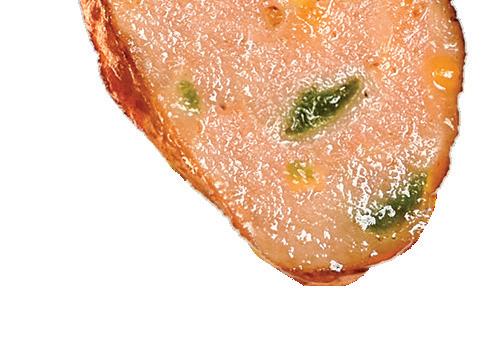









First Course

Olive Garden Tests Smaller Portions
BY BEN COLEY
Early results show higher affordability scores and guest satisfaction.
OLIVE GARDEN WANTS TO GIVE GUESTS additional reasons to visit, and one major way is through more affordable price points.
During the first quarter, the chain began testing a new menu section featuring seven existing entrées with reduced portions and lower prices. These items still
come with unlimited breadsticks and unlimited soup or salad.
Forty percent of Olive Garden restaurants currently offer this menu. Thus far, the response has been “encouraging,” according to Darden CEO Rick Cardenas. Affordability scores increased 15 percentage
Darden CEO Rick Cardenas insisted that the lower portion menu is still an abundant option for customers.
First Course
points and guests are showing “high satisfaction” with the portion size.
“It’s still pretty early. We do believe in the long run, this is a traffic driver,” Cardenas said during a Darden’s earnings call. “It will dilute our check a little bit if people trade from a higher portion size item to a lower portion size item. But we believe that’s the portion that those guests want. And very early indications are that we’re seeing a little bit more frequency. But it’s not necessarily new guests because we haven’t marketed it. We put it in restaurants without even any fanfare and it’s just people are gravitating towards that."
The CEO insisted that the lower portion menu is still an abundant option for customers. “The way we’re thinking about it is there is a consumer group out there that believes in abundance, but abundance is different for everybody,” Cardenas said. “And by bringing some smaller portion sizes to the dinner menu at Olive Garden, there are still abundant portion sizes, but it also adds price breadth to the menu. So consumers can choose. We’re not changing
our entire menu to make it a smaller portion. We are putting items on there that are smaller with a compelling price point. And at Olive Garden, you still get the unlimited soup or salad and you get all the breadsticks you want. So it’s still abundant.”
Cardenas said Olive Garden may start marketing the menu in the back half of the year to drive more customers toward the tinier entrées as the chain faces tougher comparisons. If successful, other brands in Darden’s portfolio could implement the same type of menu.
Meanwhile, Olive Garden’s firstparty delivery partnership with Uber is capturing younger and more affluent customers. These guests come with a higher check average and are highly incremental. In the first quarter, the brand advertised 1 million free deliveries, all of which were redeemed. Average weekly deliveries doubled throughout the campaign. Afterward, delivery order volume has remained about 40 percent above the pre-campaign average.
As of now, Olive Garden and Cheddar’s Scratch Kitchen are
Darden’s only two brands that use delivery. But another one may be coming soon.
“We are pleased with our firstparty delivery, both at Olive Garden and at Cheddar’s. It continues to grow for us. We do have another brand that’s wanting to embrace it, and we would expect that brand to be on the platform sometime in Q3," Cardenas said.
He adds, "I won’t tell you what brand that is, but they’re very excited to jump into the first-party delivery.”
Still though, Darden is focused on first-party delivery and isn’t keen on moving to the third-party marketplaces.
“We’re focused on first party right now," he said, "and we’ve talked about the things that we don’t like about third party. If a provider can come with every solution that we have for third party or the reasons that we don’t like it, then we would definitely consider it. But right now, we’re very comfortable and very pleased with how first-party delivery is going.”
WHERE ARE THE MOST AFFORDABLE CITIES TO DINE OUT?
A new study from Chef’s Pencil compared restaurant costs against local wages across 177 cities worldwide to shed light on dining out affordability. While U.S. tipping culture complicates the picture, Americans enjoy some of the most affordable dining-out options overall.
Nine U.S. cities rank in the global "1% Club," where a mid-range meal costs just 1% or less of the average take-home pay.
Coffee & Beer Culture: San Francisco, Seattle, and Boston are among the most affordable cities for a daily cappuccino, while Atlanta and San Francisco rank in the top 10 for beer affordability.
SOME OTHER KEY U.S. INSIGHTS FROM THE REPORT:
The American Advantage: Topping the global list is Dallas, Texas, while cities like Denver and Seattle rank well ahead of major European capitals like Paris and Berlin.
On the flip side, New York and Miami rank as the least affordable U.S. cities (no surprise there), falling below cities in the Midwest or on the West Coast.
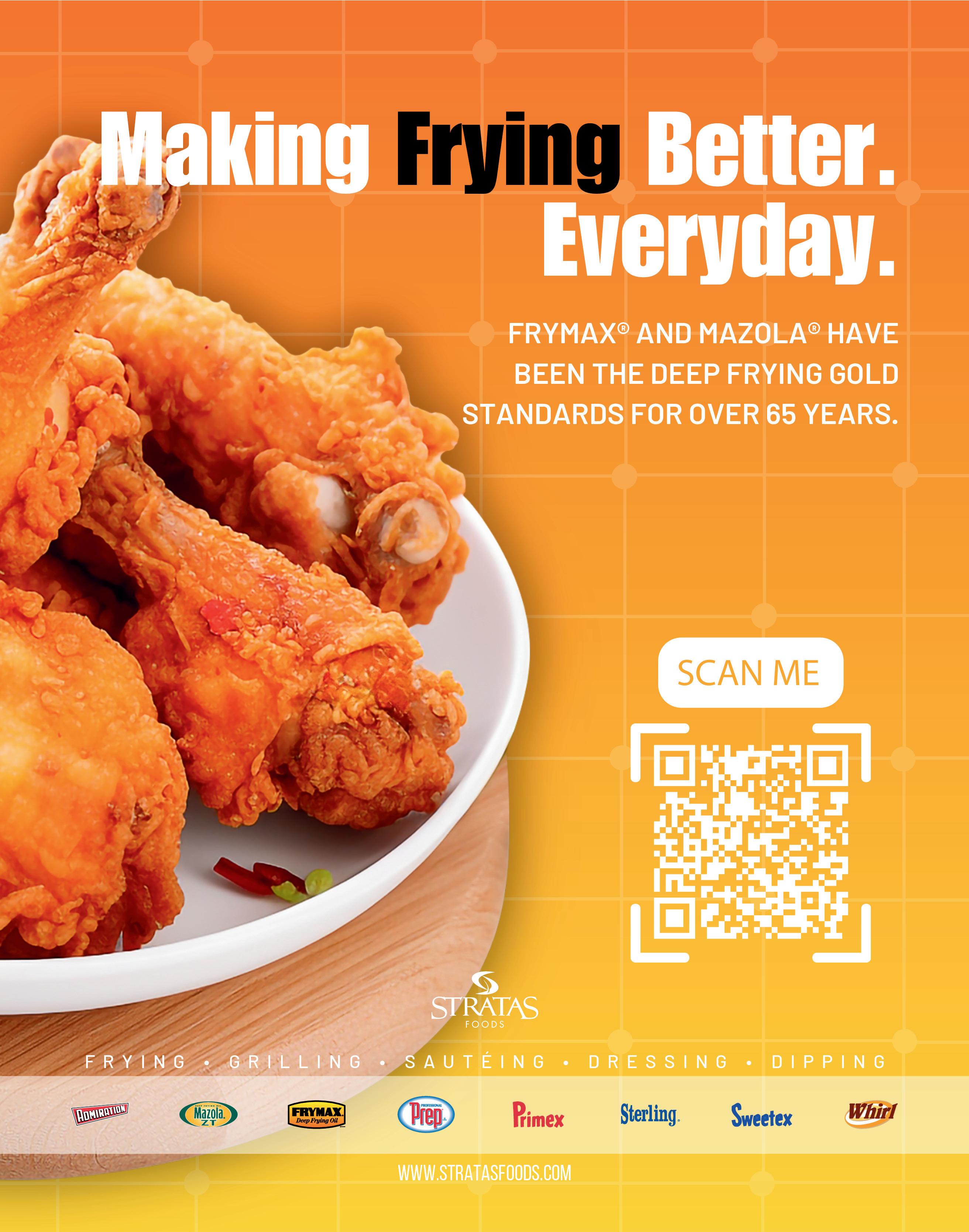
IT ALL STARTS WITH POTATOES IDAHO ®
IDAHO ® RUSSET POTATOES

IDAHO ® FINGERLING POTATOES
POTATO CAKE
Chef Serafina Truong
Serafina’s Sweet Shoppe

CULINARY INSPIRATION AND STORIES FROM INDUSTRY TRAILBLAZERS
MENTIONED IN THIS SECTION THE RITZ-CARLTON CLEVELAND
THE BRASSERIE
Chefs & Ingredients

TAMBOURINE ROOM’S SEVENCOURSE MENU BLENDS MODERN FRENCH TECHNIQUE WITH REFINED ASIAN INFLUENCE. A COUPLE HIGHLIGHTS INCLUDE PORCELET & CAVIAR WITH ROSE APPLE, YUKON ESPUMA, AND POTATO CHICHARRON; AND THE KEY LARGO SNAPPER WITH KOMBU JALAPEÑO SOFRITO, COAL FIRED ZUCCHINI, AND COCONUT CURRY BEURRE BLANC.
BY CALLIE EVERGREEN
This 23-year-old chef has a bold vision for the future of fine dining.
Plating Purpose WITH A
GROWING UP FISHING IN MICHIGAN, LOGAN McNEIL never thought he’d become a chef de cuisine at a Michelin-starred restaurant by the age of 23. Up until freshman year of high school, he thought he wanted to become a robotics engineer, until one day he took a hard pivot and decided he wanted to pursue a professional culinary career. “I got to a certain point where I realized I wouldn’t enjoy [engineering] everyday if I had it for a job, and I knew I wanted a job I was
going to be passionate about and really love,” he recalls. “Just like the flip of a switch, I switched to cooking, and I’ve never doubted it since.”
In culinary school, he recalls learning a crucial lesson about the importance of knowing your audience when he was challenged to a burger cook-off with a classmate. “I’ve never wanted to turn down a competition, and I felt like I had the win in the bag, so I happily took him on,” he says. “One thing I overlooked was that the judge for this very unofficial cook-off was a very basic cheeseburger kind of guy, and I went all out and made a very non-basic cheese -

FAVORITE CASUAL MIAMI EATERIES?
Cecile Bakery + Cafe for brunch, or a smashburger from Celia’s in Wynwood
ALT-CAREER? Robotics engineer; chefs are like engineers, just with food and ingredients
GO-TO SPICE/HERB AT THE MOMENT? At home, smoked paprika; at the restaurant, fresh dill
HOBBIES? Fishing—I grew up on a lake in Michigan. I love fishing down here when I can
SECRET GUILTY PLEASURE SNACK? Candy—Sour Patch Kids, Starbursts
FAVORITE FOODIE CITY TO VISIT? New York
burger, and I lost. I was shocked. And this guy that I was doing this cook-off with, he looked to me and said, ‘You’ve got to know your audience,’ and that little piece I use now when I create menus.”
He adds, “I look at it from a selfless point of view … of course, I create from what I’m passionate about, and try to tell my story through food. But I always, always, always have the guests in mind, because they’re the ones that we’re cooking for.”
McNeil is now the newly appointed chef de cuisine at Miami’s Michelinstarred Tambourine Room by Tristan Brandt, located in the beachfront Car -

illon Miami Wellness Resort. Worldrenowned chef Brandt made history as the youngest chef in Germany to lead a two-star Michelin kitchen, and today passes on his knowledge as a mentor for young talent like McNeil while simultaneously organizing top-tier international festivals like the Waldhaus Flims Festival of the Arts in Flims, Switzerland, and the Pfälzer Gourmet Festival in Deidesheim, Germany.
Brandt made his U.S. debut in December 2022 with the launch of Tambourine Room by Tristan Brandt, an evolution of the original concept which opened in 1958 as a space for cocktails and conversation amongst jazz legends. Nearly 68 years later, Brandt and McNeil continue to evolve the iconic venue through a reimagined lens of contemporary fine dining.
Meanwhile, McNeil brings a proven track record from Top Chef Jeremy Ford’s Stubborn Seed, where he joined as a line cook and rose to executive chef by 22.

LOCAL INGREDIENT


MICHAEL PISARRI (3)
LOGAN McNEIL
LOGAN McNEIL IS WORKING TO REDEFINE SUSTAINABLE FINE DINING IN SOUTH FLORIDA WITH A DEEP COMMITMENT TO
SOURCING.
INTO BONA FIDE BANGERS




which I believe can be done through storytelling, then we’ve probably created an experience that they’ll never forget.”
A few notable dishes from the fall tasting menu: Porcelet & Caviar with rose apple, yukon espuma, and potato chicharron; and Key Largo Snapper with kombu jalapeño sofrito, coal fired zucchini, and coconut curry beurre blanc.
As Tambourine Room approaches the winter seasons, McNeil is preparing for
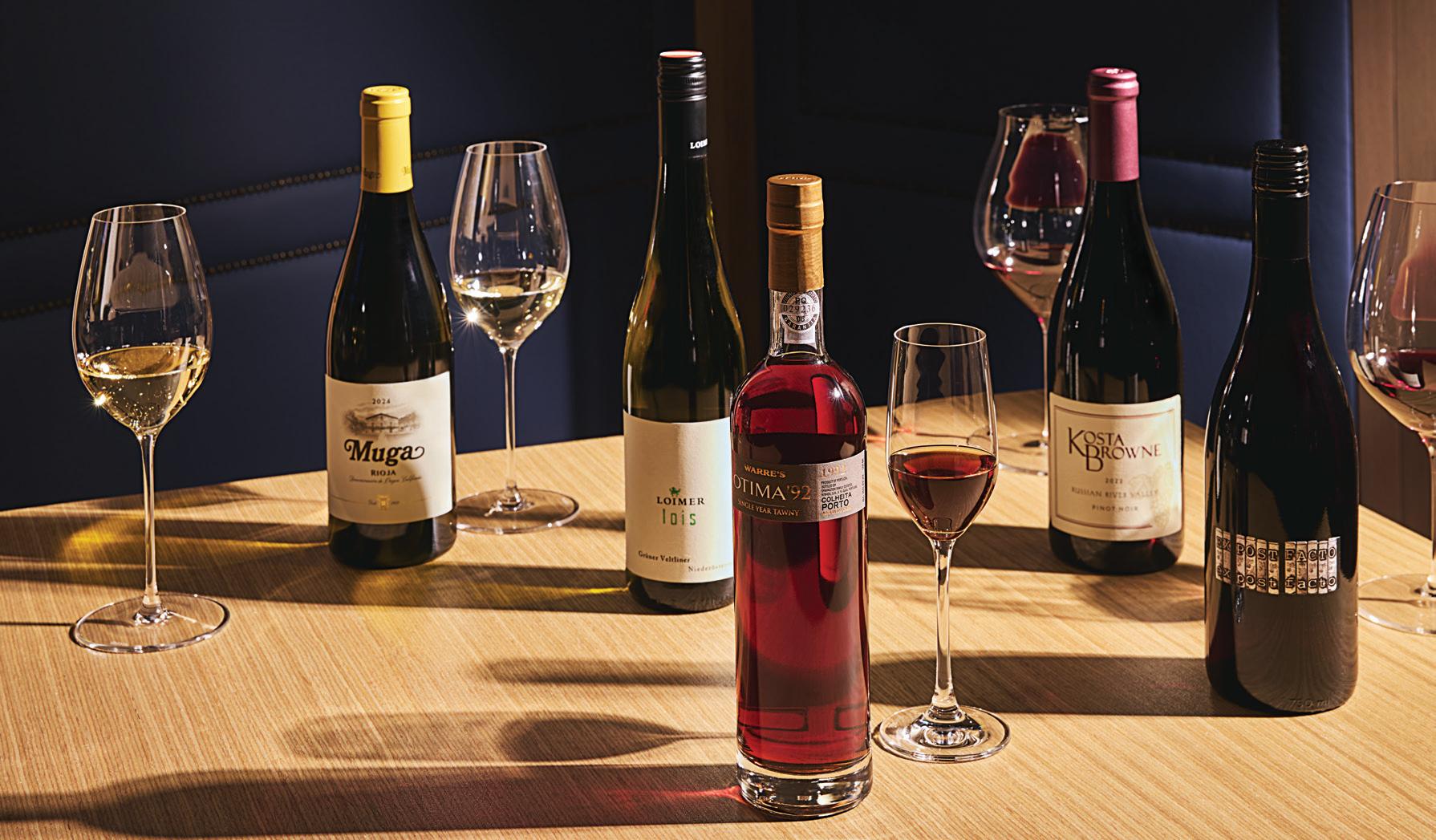

Green Star for sustainability, and spearheaded innovative composting efforts that offset more than 11,000 pounds of food waste. “Starting there at 19, I was at first in disbelief [that] I was actually able to work there,” he admits. “Throughout my time there—just being a sponge and really just working hard and being dedicated—I was able to learn so much, not even just from Jeremy, but everyone that worked there. It’s a very collaborative kitchen, and that’s where I learned how to create and I think got my culinary voice.”
At Tambourine Room, McNeil now collaborates with Brandt, blending French technique with Asian influences to create a seven-course tasting menu, with an emphasis on sustainable practices and mindful, ethical sourcing. The tasting menu is guided by honoring land, sea, and season, and each course is presented by the chef creating an immersive, narrative-driven dining experience.
The restaurant is anchored by its focus on providing an excellent guest experience—an evolution of the lesson McNeil learned in culinary school. “Our main goal is to achieve a connection with the guests,” he adds. “If we can achieve that connection on an emotional level,
a significant menu transformation that highlights South Florida’s agricultural bounty. In November, approximately 95 percent of the restaurant’s produce comes from organic farms in the region.
Unlike Florida’s challenging summer growing season, characterized by intense heat, the fall and winter months offer an abundance of fresh, local ingredients. Having personally visited many of these farms, McNeil is passionate about showcasing the region’s agricultural diversity. This approach not only supports local farmers, but also allows the chef to help craft a menu that truly reflects the terroir of South Florida, making it his favorite time of year for culinary creativity.
For McNeil, ingredient sourcing is as much about ethics as it is about flavor— a passion and authenticity that shines through while talking to guests. “I can regurgitate words all night long to the guests; I think it only really has meaning if I am passionate about it as well,” he says. “Any stories I tell about ingredients or vendors or how things were
grown or harvested are stories that I’ve heard from the vendors themselves, or maybe even just things that I’ve been to the farms and I’ve seen the process, and I myself have taken the time to learn about it, hands-on, first-person, and become equally as passionate about it. So then when I speak to the guests, it’s not just words that I’ve rehearsed, but it’s something I’m actually excited and passionate about and love.”
That focus extends to the sea as well. McNeil and Brandt source fresh Florida oysters from Everglades Oysters farm, a 74-acre regenerative farm pioneering Gulf restoration through a circular shell recycling program.
The restaurant’s sustainability ethos is woven into every corner of its operation, from composting to oil alternatives. They use sustainable, fermented sugarcane oils from Zero Acre Farms, which helps eliminate seed oils, which are linked to deforestation, McNeil notes, and it allows them to cook with a cleaner product that’s better for the planet and guests. “The oil that they actually produce through their process is one of the healthiest oils that there is to consume. It really doesn’t have negative effects, yet it still yields very high-quality oil, very high smoke point for cooking, very neutral flavor. It’s very versatile in our kitchen,” he explains.
While McNeil’s attention to sourcing is deeply intentional, his philosophy is far from performative. “People just have come to realize that as chefs, we take so much life from the earth, because everything we use to cook was once living, and what are we doing to give back?”
In many ways, McNeil sees Tambourine Room as a reflection of where fine dining is headed in the future—a balance of artistry, ethics, and emotion. He adds, “I think sustainability and ethics are definitely trending right now, but I don’t think that’s going away. I think that’ll just be the new way of responsible cooking, and my hope is that we won’t stand out for doing it in the near future. That’ll just be a normal thing, because it truly is a better way to go about what we do as a craft.”











MICHAEL PISARRI (2)








































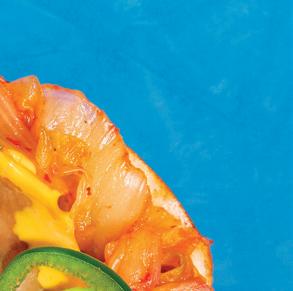
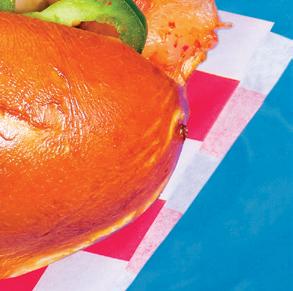






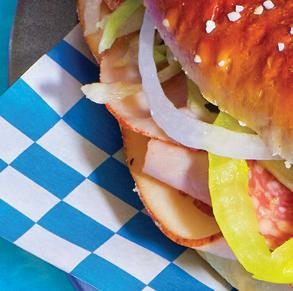










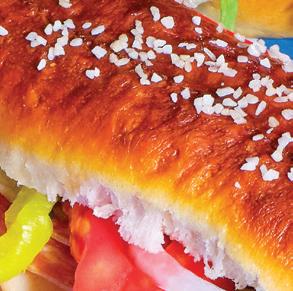
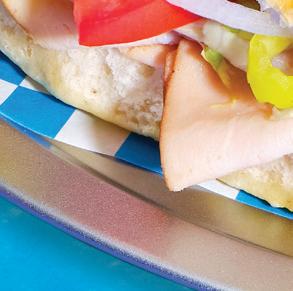




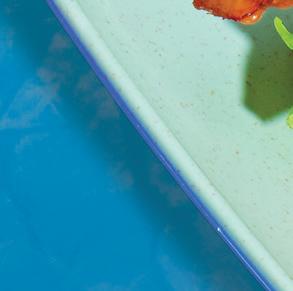



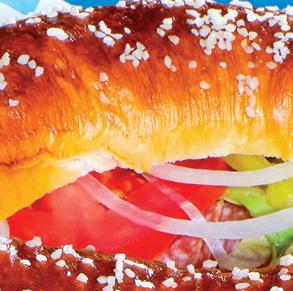

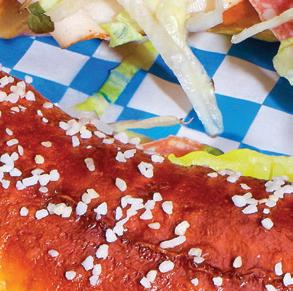








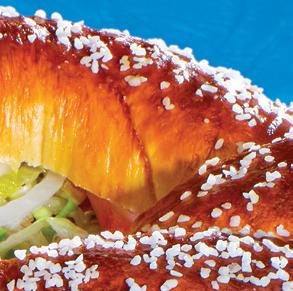





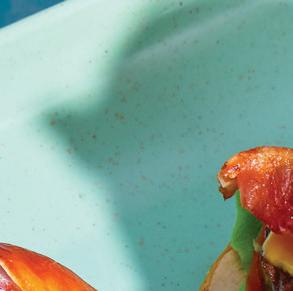

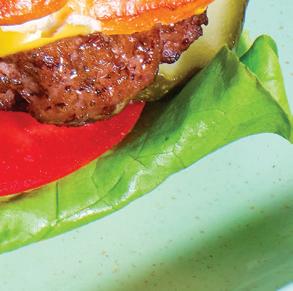




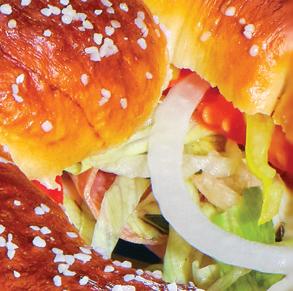
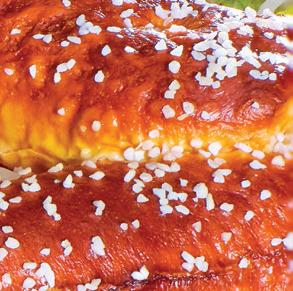









The New Language of Dessert
BY SATYNE DONER
The final course has become a canvas for storytelling, blending memory, artistry, and innovation.

DESSERTS ARE NO LONGER just a sweet ending; they’ve become statements of identity, a way for restaurants to showcase culture, craft, and care. From elevated Southern comforts to Middle Eastern pastries and playful Asian classics, the final course is evolving into one of the most dynamic parts of the dining experience.
In September, Uchi Miami debuted its first lunch service, offering seasonal sorbets alongside its elevated Japanese cuisine. During Miami’s long, hot
summers, these scoops have become a refreshing escape for customers.
Ariana Quant, executive pastry chef at Hai Hospitality, the parent company of Uchi, gets excited when customers skip the sushi and come in just for dessert. In addition to mochi ice cream and sorbet, Uchi’s Fried Milk Dessert has become a signature. It features fried milk, vanilla, chocolate, and corn flakes, creating a sense of nostalgia and comfort.
Uchi doesn’t shy away from dessert innovations on its dinner menu either.
“We have whipped jasmine cream, cilantro granita, and honey tuile treats that are unexpected and exciting. I love incorporating notes of savory and sweet into the menu to surprise our guests and open their eyes to what dessert can be,” Quant says.
Also located in Miami is Amal, a Lebanese-inspired restaurant with a menu that seeks to put a new perspective on long-held traditions. The menu embraces Lebanese spices and values, like communal dining, alongside Miami’s bright and
THE DESSERT THAT BEST REFLECTS AMAL’S CULINARY PHILOSOPHY IS THE DATE CAKE, MADE OF RICH DATES, BUTTERSCOTCH SAUCE, VANILLA ICE CREAM, AND HONEY TUILE.

coastal flavors.
“In Lebanese culture, we have mezze, which is the intention of a dish to be shared. Our desserts are indulgent, so although one person can finish it, we encourage everyone to take a bite,” Antoin Garcia, executive pastry chef at Amal, says.
Desserts include the Chocolate Halva Mousse, topped with sesame brittle and tahini chantilly; the Kanafeh, with cheese, semolina dough, and rose water; Mastika Ice Cream, with notes of cotton candy and pistachio; and Baklava, with pistachio, walnut, cinnamon, and vanilla ice cream.
For Garcia, the dessert that best reflects Amal’s culinary philosophy is the Date Cake, made of rich dates, butterscotch sauce, vanilla ice cream, and honey tuile. It’s a best-seller, ensnaring guests with its modern design but traditional flavors.
Amal also offers dessert wines to complement its sweet treats and balance guests’ palates, like the Touriga Nacional Blend Port, with notes of deep, dry fruits, cherries, and plums, accompanied by nutty, spicy, and citric flavors—a per-
fect encapsulation of Lebanese tastes.
Tai Er’s flagship restaurant in the Bay Area explores modern Chinese cuisine, playing with bold Sichuan flavors and textures. This global dessert experience offers a refreshing counterpoint to the dinner menu, which director of marketing Kevin Liu describes as rich, layered, and intense.
The Mango Pomelo Sago stands out as a bridge between traditional and modern Asian cuisine, with chilled mango coconut sago topped with pomelo and juicy yellow peach chunks—it’s creamy and citrusy. There’s also the Coconut Ice Jelly, which blends ice jelly and coconut milk for a tropical finish. A fan favorite includes the Fried Mochi Cubes, highlighting sticky rice mochi cubes and vanilla ice cream drizzled in brown sugar syrup.
“Texture is essential to Chinese dining, where everything is about contrast,” Liu says. “Crispy and tender, chewy and crunchy, indulgent and light. Our desserts seek to layer textures and flavors to create a dynamic and engaging experience.”
At The Brasserie—the signature restaurant at Hotel 1928 in Waco, Texas—
dessert takes inspiration from locally sourced ingredients and elevated Southern comfort, celebrating Texan seasonality while keeping an approachable dining experience at the forefront.
Options include the Fried Peach Pie with vanilla gelato and salted caramel; the Triple Chocolate Delight cake with whipped ganache, cocoa powder, and cashews; the 1928 Cheesecake with candied lemon and blueberry compote; and bread pudding paired with whiskey caramel, gelato, and cloud dust.
Executive chef Jared Estes believes customers gravitate toward a wellrounded selection of recognizable flavors and seasonal offerings, such as locally sourced peaches and berries. He lets the seasons and the aesthetics of Hotel 1928 guide his menu decisions.
“If you pay attention to what’s growing together at any specific time, those flavors tend to work out really well. Nature does the work for us as chefs,” Estes says. “We hang our hat as a brand on approachability and refining Southern comfort. We use that as our kickoff point and let the food do the talking.”
The Ritz-Carlton Cleveland also leans into local flavors. For example, pastry chef Emmanuel Palmas Lozada incorporates locally sourced maple syrup into his breads and desserts. But the standout offering plays into traditions, the holidays, and the experiential.
In December, the Ritz-Carlton will bring back its iconic Gingerbread Chalet, a private dining room made of 4,000 gingerbread “bricks,” 500 pieces of candy, and at least a mile of piped frosting, which serves as the mortar between the walls and bricks. The team bakes from August to November in preparation for the life-sized dessert.
“We are making art with sugar and chocolate,” Lozada says. “We’re creating memories for life. When you’re traveling in another part of the world, in another hotel, in another restaurant, and you taste the familiar dessert flavors we use here, it feels comforting. You can taste these memories from any part of the world, and to me, that’s what makes dessert unforgettable.”
HAI HOSPITALITY
IN ADDITION TO MOCHI ICE CREAM, UCHI’S FRIED MILK DESSERT HAS BECOME A SIGNATURE, FEATURING FRIED MILK, VANILLA, CHOCOLATE, AND CORN FLAKES, CREATING A SENSE OF NOSTALGIA.

BEVERAGE TRENDS TAKING OVER RESTAURANTS 2025

Beverages have taken center stage in the restaurant space. No longer just the sidekick to meals, drinks have become the main attraction, with consumers increasingly visiting restaurants for “beverage-only” occasions. In 2025, that shift has been powered by Gen Z and Millennials, who see beverages as more than refreshment—they’re moments for wellness, indulgence, and self-expression, often amplified through social media.
For operators, this evolution unlocks enormous opportunity. Beverages are now a canvas for creativity, cultural relevance, and incremental sales growth. “Drinks are a big part of the growing ‘treat yourself’ culture,” says Carrie Gillespie, field sales marketer at Monin. “Consumers may not
always splurge on a big-ticket item, but they’ll absolutely splurge on a drinkable dessert or colorful refresher.”
Dirty sodas and dessert-inspired beverages are surging, fueled by consumer nostalgia and the desire for personalization. “Guests can choose their preferred soda base and then customize their base with Monin syrups and creamers,” Gillespie says. “This freedom enhances the customer experience and allows each guest to reconnect with dessert and nostalgic flavors in a way that feels fresh and unique.”
In addition to indulgence, consumers
also want their beverages to do more than taste good—they want function. Energy refreshers and protein-packed coffees have gained traction. According to Datassential, protein coffee sales have grown 154 percent over the past four years, with another 33 percent growth projected by 2029. At the same time, natural energy boosters are replacing high-octane energy drinks with cleaner, focused fuel.
Every year has its breakout flavor, and in 2025, yuzu was crowned Flavor of the Year. “It combines the brightness of lemon with hints of floral, grapefruit, and mandarin notes,” Gillespie says. “The rise in yuzu’s popularity follows a broader trend— the growing fascination with Southeast Asian fruits, including dragon fruit, lychee, and ube. Each of these fruits offers something unique, but yuzu’s ability to deliver both familiarity and intrigue makes it especially resonant with today’s adventurous consumers.”
Social media is accelerating these trends, pushing operators to deliver “wow factor” beverages that photograph beautifully and spark conversation. Bright colors, unique garnishes, and bold flavor combinations are all helping restaurant operators capture those viral moments.
Heading into 2026, beverage menus will continue to evolve around natural ingredients, transparency, and functional benefits. Gillespie expects more Mediterranean-inspired flavors, playful beverage textures, and even savory notes such as cucumber mint or spicy maple.
By partnering with flavor experts like Monin, restaurants can keep pace with fast-moving trends while balancing operational ease. As Gillespie notes, “Consumers are more likely to make a special trip for a signature beverage they can’t find anywhere else.”
In 2025 and beyond, the right beverage strategy will continue to drive traffic, spark social buzz, and keep restaurants at the center of the cultural conversation.
By Abby Winterburn




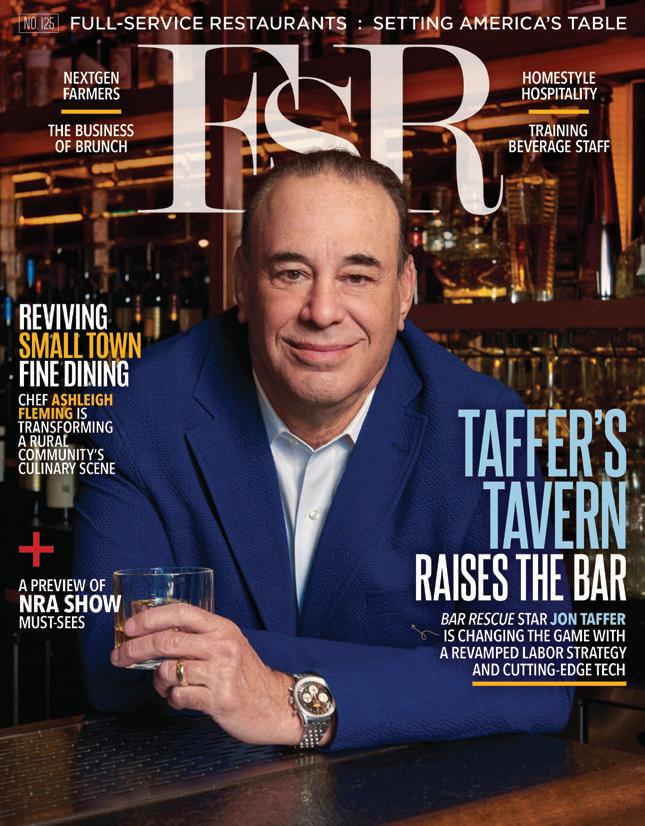
You should know—you’re one of them.
You’re what we at FSR like to call “tablesetters.”
You make things happen in the restaurant industry.
You’re an innovator on your menu and in all aspects of your operation.
You’re watched and emulated by other restaurateurs.
You lead the markets you operate in.
These are the characteristics that make a tablesetter. And FSR is the trusted source of information for these most influential chefs and restaurateurs in the industry. Request your free subscription today by visiting FSRmagazine.com/subscribe
Restaurants : Setting America’s Table
TRENDS AND CREATIVE APPROACHES TO SPIRITS, WINE, AND BEER.
MENTIONED IN THIS STORY MONDAY NIGHT BREWING • COJE • PARTY FOWL • THOMPSON RESTAURANTS • TAPSTER
Show-Stopping SIPS Liquid Intelligence
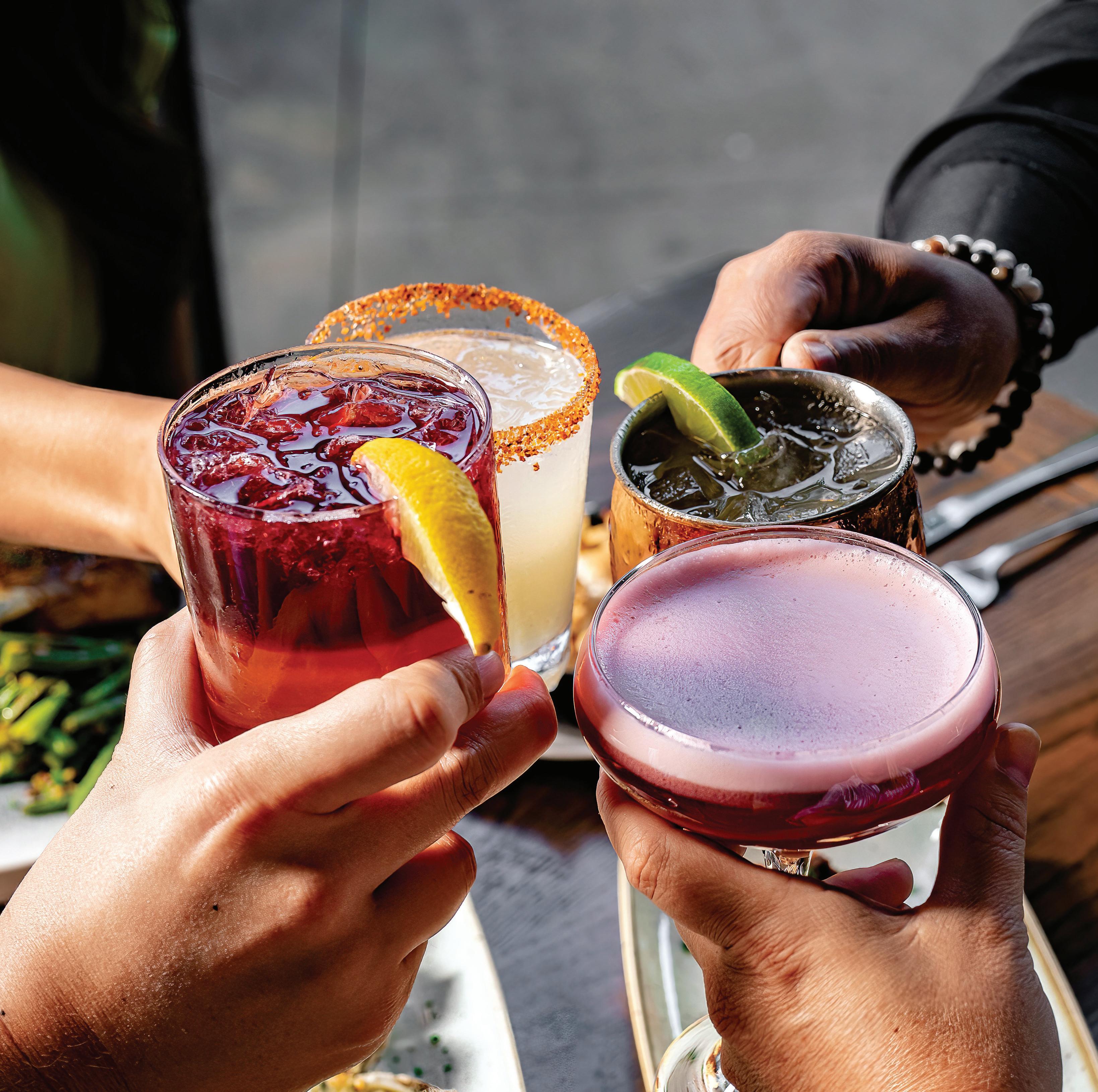
FROM SELF-POUR TO SMOKED OLD FASHIONEDS, RESTAURANTS ARE TAPPING INTO THE SPECTACLE OF PREMIUM BEVERAGE SERVICE.
BY SAM DANLEY
Designing premium drinks requires storytelling—and training staff well.
CREATING DRINKS THAT STAND OUT isn’t just about flavor. It’s about delivering an experience that guests remember, talk about, and hopefully even come back for. The question for operators is how to craft beverages that not
only taste good, but also capture attention the second they hit the table. Scott Taylor, CEO of R&R Brands, thinks about it in terms of theater. His hospitality and entertainment group spans about 50 locations across mul-

tiple states, and he likens the strategy to the timeless restaurant move of sending out a sizzling plate of fajitas. The sound and aroma turn heads, and suddenly other guests start thinking about ordering fajitas for themselves.
“It’s the same thing with a drink, whether it’s a smoked old fashioned or whatever it may be,” Taylor says. “What can you do to create some buzz when people see it go by?”
At Party Fowl, an R&R concept specializing in hot chicken and big, boozy drinks, that buzz comes in the form of oversized, eye-catching, and playful drinks that Taylor says are designed to “create a moment.” The lineup includes technicolor slushies topped with mini airplane bottles, a bloody mary gar -
taps across categories including beer, cider, wine, cocktails, hard seltzer, and more. Guests tap their card on the screen above each selection and are charged by the ounce as they pour. “The beauty is that we really promote sampling and trying different things,” says founder and CEO Roman Maliszewski. “I always say it’s the Froyo of drinks.”
The model puts control in guests’ hands and reduces staffing needs, but it doesn’t come at the expense of social interaction. “You see somebody with a drink that looks interesting, or they’re pouring from a tap you want, and it’s so easy to engage with them,” Maliszewski says.
Visual appeal plays a role here, too. He notes that a brightly colored cocktail or an experiential twist like a slushy can quickly catch on. Once one person pours a glass, others follow. And with every Tapster location designed with swing set tables and large communal areas, the environment encourages both in-person conversation and social media sharing. “I think just going up to the taps themselves is Instagramable, too,” Maliszewski says. “People just love to go up and try different things.”

nished with an entire fried chicken, and brunch cocktails served with IV bags that drip directly into the glass.
The Urban Cowgirl Cocktail—made with vodka, prickly pear, lemon, and prosecco—arrives in a disco ball cowgirl hat cup. (“And yes,” Taylor notes, “you get to keep the cup.”) Inside the restaurant these drinks create buzz, and online they extend it, with guests posting plenty of photos of the eye-catching presentations.
Tapster has a similar goal of creating memorable, shareable experiences. The self-pour tasting room features 40–60
As the COO of Thompson Restaurant Group, Alex Berentzen oversees a portfolio of 70 restaurants across 16 brands. He sees the beverage landscape shifting with more consumers cutting back or abstaining from alcohol altogether. But for those who do drink, the data show growth in two directions: budget-friendly and ready-to-drink options on one end, and premiumization on the other.
On the premiumization front, one restaurant in the portfolio has a $22 smoked old fashioned that recently became a top seller. Another hit is the Prescription for Peaches cocktail, which Berentzen describes as a playful nod to Prohibition. “It comes to your table in a hollowed out book with a flask in it,” he says. “It’s a batch cocktail, and we’re just pouring it table side. It’s about the easiest thing we can do, but it works. And it sells.”
DRINK DESIGN TODAY MEANS CREATING BUZZ-WORTHY MOMENTS THAT SPARK CONVERSATION AND DRIVE RETURN VISITS. WHETHER IT’S A $22 SMOKED COCKTAIL OR A DAIQUIRI TREE, DRINKS ARE GETTING BIGGER, BOLDER—AND MORE PROFITABLE.



The bigger story is how to empower staff to create these kinds of experiences consistently, he adds. Thompson Restaurants invests heavily in bartender education, sponsoring programs like Bar Smarts and the Wine & Spirit Education Trust (wset). “When we talk about innovation, it’s about arming people with knowledge,” Berentzen says. “It starts with training so that they have the confidence to sell the product.”
COJE Management Group operates a diverse collection of restaurants, cocktail bars, and nightlife venues in Boston. Beverage director Ray Tremblay says the goal is often to transport guests beyond the city. Rather than walking into another pub or steakhouse, he wants visitors to get a sense of escape.
Mariel, for example, is a Cubaninspired concept that blends restaurant, bar, and lounge. The space evokes prerevolutionary Havana through the food and the atmosphere.
“It’s always something different and unique with the drinks, too,” Tremblay says. “We have daiquiri trees. We play around with fire. We have something that involves dry ice. We have batch cocktails that can go very large.”
But Tremblay emphasizes that spectacle only works if the team knows how to execute it. He points to the practical need for training: understanding how to safely use dry ice or fire, how to balance dilution in large-format cocktails, and how flavors evolve or degrade over time.
“Education is really at the root of it,” he says. “We can come up with these ideas a millionfold over, but if we’re not actually teaching them how to execute it, it tends to fall flat.”
The same principles of presentation, experience, and creativity apply to the non-alcoholic segment. If anything, these beverages require just as much if not more attention to keep guests engaged.
At Tapster, non-alcoholic choices are built into the model. Every location has taps dedicated to kombucha, CBD seltzers, mocktails, and cold brew coffee. Maliszewski says they’re popular across different age groups and rarely sit unused. And while Gen Z is often cited as the driver

AT PARTY FOWL, AN R&R CONCEPT SPECIALIZING IN HOT CHICKEN AND BIG, BOOZY DRINKS, BUZZ COMES IN THE FORM OF OVERSIZED, EYE-CATCHING, AND PLAYFUL DRINKS DESIGNED TO “CREATE A MOMENT.”

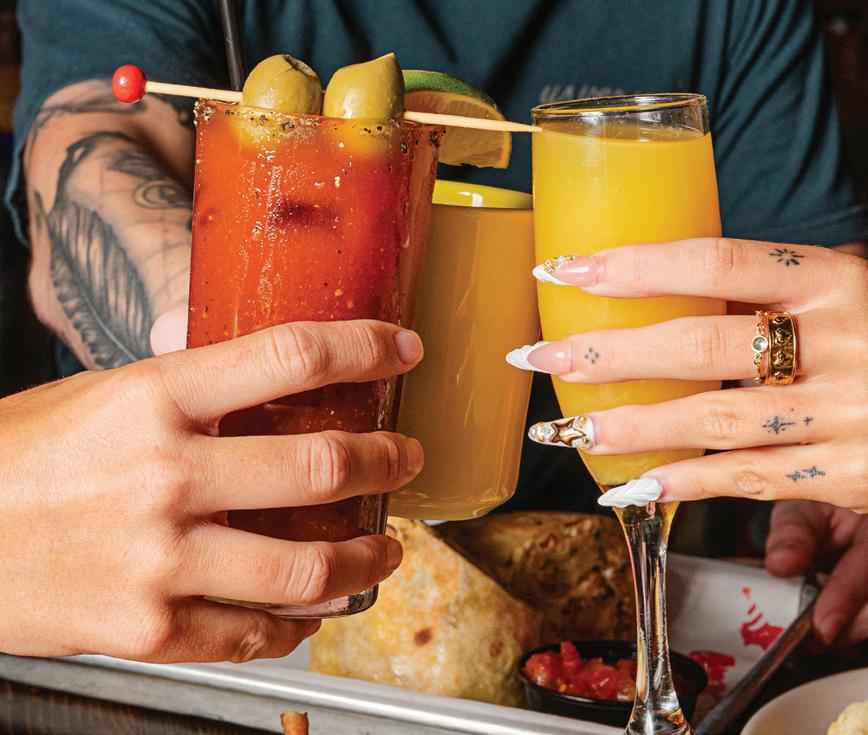
of the non-alcoholic trend, he points out that it’s not the same everywhere. Tapster opened earlier this year in Lexington, Kentucky, and “the Gen Z crowd is definitely drinking there,” he says.
Peter Kiley, brewmaster and co-owner of Atlanta-based Monday Night Brewing, agrees younger consumers are drinking less, but thinks the headlines can be misleading. “Some of the numbers that are
coming out now are showing that they simply don’t have as much disposable income,” he says. “It’s not always that they don’t want to drink.”
He also worries that younger drinkers have come of age during what he calls a “race to the bottom” in beverage quality. “There’s so many people that have this mindset of ‘What can we get away with?’ or ‘What’s the cheapest thing that we can sell our customers?’” Kiley says. “Can you imagine how much different your experience would be if everything that you purchased, the person that made it cared about offering it to you at the highest quality and the most affordable price? This doesn’t exist anymore.”
Regardless of the reasons, the numbers are clear. A 2025 Gallup survey found that just 54 percent of U.S. adults said they drink alcohol. That’s the lowest level in three decades. The shift is especially pronounced among young adults, whose drinking rate has not only declined steadily over the years, but now sits slightly below that of middle-aged and older consumers.
“But they’re not trading in flavor for alcohol,” Tremblay says. “In fact, they’re expecting a little bit more.”
That expectation is forcing operators to rethink how they approach non-alcoholic beverages. Gone are the days when a “mocktail” meant a sugary, flat drink in a plain glass. Today, zero-proof drinks are expected to have the same creativity, presentation, and guest appeal as their boozy counterparts. When done well, they also justify premium pricing.
“If we’re charging up to $25 for a cocktail, we need to make sure that we’re letting people know that these alternatives are not devalued drinks—that we’re not giving you the swell, the bottom, the low-quality,” Tremblay says, adding that in some cases, non-alcoholic spirits are actually more expensive per ounce than the liquor they replace. “When I’m pricing, these drinks are usually around 70-90 percent of what I’m charging for a cocktail, because we’re using the same quality of ingredients, the same prep, and the same love that we’re putting into all of our other beverages.”









THE NEXTGEN 25 5
These restaurant brands are raising hospitality standards and showcasing how to grow with people-first cultures and great food.
BY CALLIE EVERGREEN AND FSR STAFF
IN 2025 AND BEYOND, THESE 25 RESTAURANT BRANDS are ones to watch. From one location to over 100, this report spotlights polished full-service concepts that are prioritizing growth—but not at any cost. The NextGen Casual movement is marked by restaurants and leaders who aren’t afraid to take risks for the sake of improvement and for the pursuit of excellence. That can mean turning away prospective franchise partners if they don’t align with your values, and it can also mean saying yes to costly investments in people, culture, training, or upgrading outdated tech or infrastructure.
From Red Phone Booth’s speakeasy membership club to KPOT Korean BBQ’s unique service style, these restaurant concepts vary widely in cuisine type and growth approach—but are united in a common mission to create amazing dining experiences for guests that go beyond the ordinary. Without further ado, FSR presents the 2025 NextGen 25 list. A



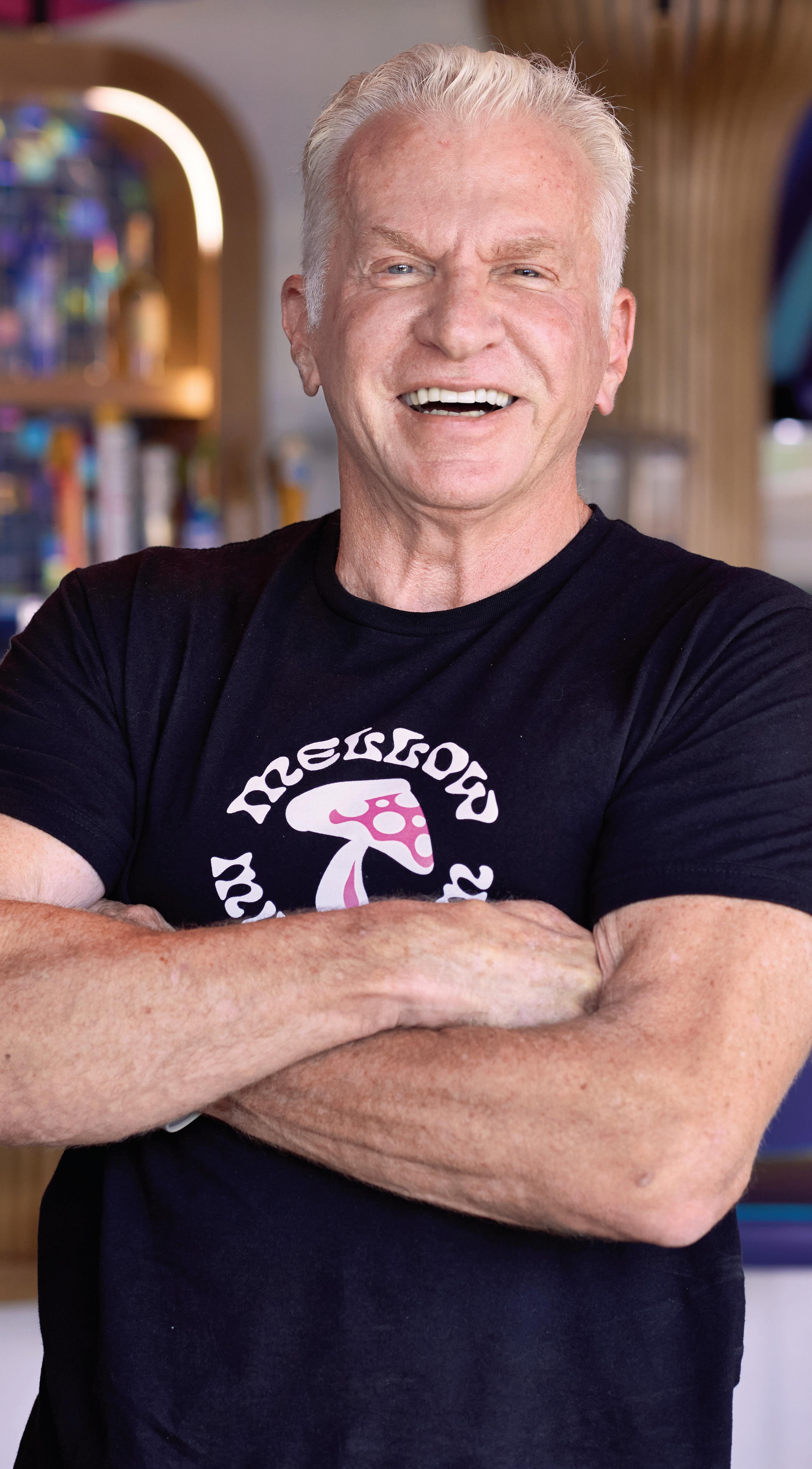
Mellow Mushroom
ATLANTA,
GEORGIA
FOUNDED: 1974 UNITS: 170
How did a psychedelic mushroom-themed restaurant evolve from a single pizza joint in Atlanta into a 170unit powerhouse that’s still growing after 50 years? The story of Mellow Mushroom started with three college students who were passionate about pizza. At age 76, Marc “Banks” Weinstein is the lone co-founder still involved in the business; Mike Nicholson and Rocky Reeves retired in 2008, when Richard Brasch stepped in to lead the company. Brasch’s path to CEO was anything but traditional, and his journey with the brand actually started back in the ‘80s. A former firefighter in Miami, he wanted to go to college but didn’t have the funds—so his cousin, Mellow Mushroom cofounder “Banks,” helped him land a dish-pit job in the back of a Mellow Mushroom near Emory University, one of just five company locations at the time. “I loved the people, but it was a company run by entrepreneurs, so it wasn’t the most structured environment to work in, in terms of systems and practices,” Brasch recalls. After working at the brand to fund his undergraduate education, Brasch left for law school in California and later became a corporate general counsel in Miami. When one of Mellow Mushroom’s founders called, say-
MELLOW’S RISE
ing the company was growing and needed someone to manage the business side, Brasch packed up his family and moved to Peachtree City, Georgia. The career move might have looked like a step down, but Brasch saw opportunity. “The company had a great product and a loyal cult following,” he says; but what they needed were the systems, processes, and structure to scale it up. That unconventional leap became part of the Mellow Mushroom story itself—proof that the brand has always embraced the unexpected. For Brasch, it also means he’s uniquely positioned to honor Mellow Mushroom’s 50-year legacy while leading it into its next era of growth.
FROM CHAOS TO COHESION
When Brasch rejoined Mellow Mushroom in the early 2000s, the company had 25 franchisees—five of whom remain today—but no one dedicated to franchise development or sales, and the structure was strained as co-founders juggled outside ventures. Despite limited franchise advertising, interest in the brand was growing thanks to its cult following. Brasch began adding resources, professionalizing operations, codifying recipes, and building the framework that would ultimately allow Mellow Mushroom to scale.
Remaining a privately owned company has allowed Mellow Mushroom to be focused on long-term goals, versus being focused on providing investors a return on a quarter-to-quarter basis, he notes. “We absolutely believe
it’s better for the health of the brand in the long run to operate under that environment. So we’ve always made decisions in that regard, because there’s always ways in the restaurant business to do things cheaper, easier, pre-made, frozen,” he says. “But if you start doing too many of those things, it’s death by 1,000 cuts.”
The proof is in the pizza: Mellow Mushroom’s crust starts with dough made from five simple ingredients and Appalachian spring water, and is hand-tossed and stone-baked to achieve a uniquely Southern style— thicker than New York, thinner than Chicago. The mozzarella is a proprietary blend from master cheesemakers, complemented by 10 specialty cheeses ranging from sheep’s milk feta to dairy-free options. Seasonal offerings like the Taco Nirvana menu and Mellow Rollz showcase the brand’s playful experimentation, all while staying true to its uncompromising standards.
“Adhering to those standards and being fixed on those principles is part of the reason that we have basically blind loyalty in many instances. You still have to deliver the goods, you’ve got to make the food properly, you have to have great service—but we’ve always stayed aligned with our principles,” Brasch says.
NAVIGATING THE REBRAND
Relevance has always required evolution—not necessarily total reinvention, which we’ve seen play out in the news in the past year with brands that

have strayed too far from their core DNA and customer base. Mellow Mushroom embarked on its largest rebrand in history in late 2023, introducing a refreshed logo and a unified digital experience. For a brand built on uniqueness where no two restaurants looked alike, that kind of change required sensitivity. “I love every store is a snowflake. But as you evolve and recognize the changes in the marketplace, you have to come to grips with a reality of, if every store is a snowflake, snowflakes are more expensive,” Brasch explains.
“What we had to do,” he explains, “was take the philosophy of having some aspects—some snowflakes—within the buildout of the brand, but recognize that we needed economies of scale. We can still make each restaurant feel one-ofa-kind without looking like every other brand out there.”
Brasch aimed to strike a

balance between structure and creativity by offering design frameworks while still commissioning local artists for each restaurant. Some longtime franchisees initially resisted, fearing the brand was becoming “too corporate.” “People hate change,” Brasch says. Over time, he showed that the goal wasn’t to erase individuality but to strengthen brand recognition—a successful strategy resulting in 95 percent franchise renewals today.
“We want to make it easier for you to be success -
ful in your business,” he recalls telling them. “People love our brand, but if they don’t recognize your store as a Mellow Mushroom instantly when they’re driving by, that’s potentially rev-
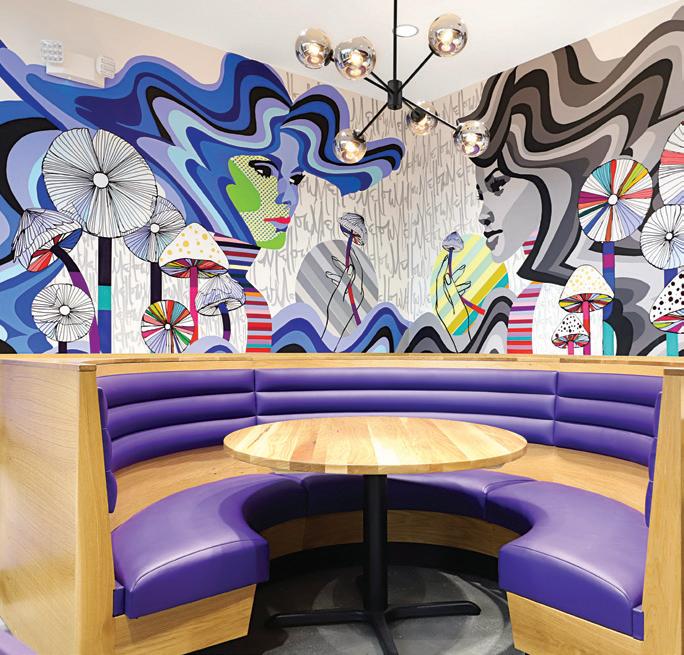
THE NEXT ERA
Earlier this year, Mellow Mushroom debuted a new prototype dubbed Project Wonderland—a smaller, counter-service style model designed for greater efficiency and flexibility. The new design cuts the traditional footprint nearly in half and trims complexity without cutting standards. Early results have been promising after only being open for about six months as of press time, showing stronger margins and a higher off-premises mix.
Crucially, Brasch frames Project Wonderland as an

enue that you’re losing.” Ultimately, he adds, the update wasn’t about conformity— it was about longevity. “You don’t want to be Blockbuster,” Brasch says.
“We have to be mindful and not be arrogant and continue to do things the way we did,” he says, adding “You have to continue to grow and evolve.”
COVID. That’s long-range decision making. When you’re running the company on a quarter-to-quarter basis and focused on those returns, you don’t make those decisions, because people are expensive. You’re adding people, you’re adding technology, so that’s the sort of decision making that we can do.”
Reflecting on the culture at Mellow Mushroom, Brasch notes the value of treating people with respect and dignity, showcased by employee longevity. “We have people that have been here at the company for 20, 25, 30 years,” he adds.
At headquarters, Mellow Mushroom remains a family affair. Brasch’s daughter Elizabeth is EVP of marketing, his daughter Olivia is associate director of media and communications, and his son-in-law Ahsan Jiva is EVP of strategy and transformation. “They’ve all earned their positions,” Brasch notes. “Nobody in the family just walked into a management or higher management position.”
He hopes the brand stays family-run—“that’s something rare in America today”—and views nurturing the next generation as vital to succession.
Puesto
SAN DIEGO, CALIFORNIA
FOUNDED: 2012 UNITS: 8
San Diego’s Puesto has become synonymous with elevated Mexican dining with its vibrant spaces, award-winning tacos, and a familydriven passion for craft. Founded by the Adler and Lombrozo brothers, the first-generation Mexican-American team reimagined the flavors of their childhood through a SoCal lens, and won fans over with crispy cheese–wrapped tacos on handpressed blue corn tortillas and house-brewed Mexican lagers. Now, Puesto is taking its artistry nationwide. The beloved brand is opening its first out-of-state location at Nashville Yards in 2026, marking the next step in its expansion beyond California. With its lively energy, handmade tortillas, and James Beard–recognized bar program, Puesto continues to define modern Mexican hospitality.
addition, not a replacement, for full builds. “Our full-service restaurants are basically the meat and potatoes of the company. We’ll continue to open up more of those stores,” he says, while also stressing corporate investment alongside franchising.
He adds, “We had to invest in the infrastructure, so we’ve done that more post-
Five decades after its founding, Mellow Mushroom remains one of the few full-service pizza brands still privately held and fiercely independent. Its psychedelic murals and irreverent humor still draw guests in—but it’s the consistency of the pizza, the warmth of its people, and the vision of leaders like Brasch that keep them coming back.
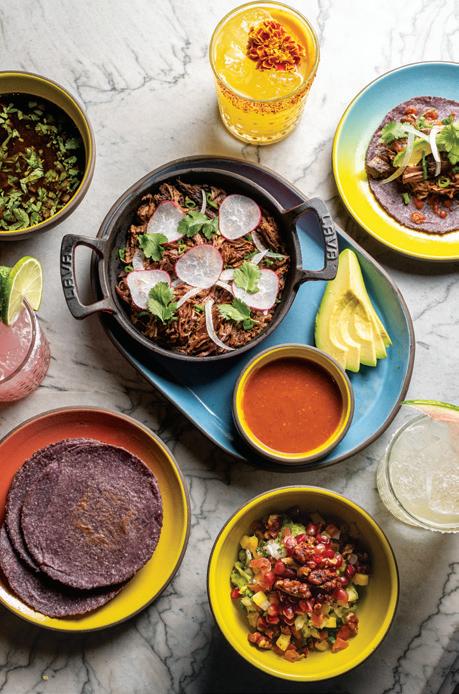
Cooper’s Hawk
DOWNERS
GROVE, ILLINOIS
FOUNDED: 2005 UNITS: 70
Founded in 2005 by CEO Tim McEnery at just 29 years old, Cooper’s Hawk Winery & Restaurants has grown into one of the nation’s most admired experiential dining brands, now spanning 70 locations across 11 states.
At the heart of its success is the Cooper’s Hawk Wine Club—the largest in the world with more than 800,000 members. Each month, members receive a new handcrafted wine, tasting notes, and recipes, along with exclusive perks such as wine tastings, rewards, special events, and curated travel experiences. This sense of community has become a defining feature of the brand, uniting members who share a love for great wine, food, and connection.
Behind the scenes, Cooper’s Hawk partners with premier vineyards across California, Oregon,
Chile, Argentina, Australia, and Italy to produce more than 50 varietals that have collectively earned over 600 awards. Each restaurant blends a modern casual dining room, Napa-style tasting room, and retail marketplace, while Executive Chef Matt McMillin and Master Sommelier Emily Wines lead the brand’s culinary and beverage innovation.
McEnery has built a team of more than 4,000 employees who embody a culture of humility, respect, and personal growth—values that mirror his mission to connect people through food, wine, and hospitality. Nearly two decades later, Cooper’s Hawk continues to redefine modern dining: accessible, elevated, and deeply rooted in community. With thoughtful expansion from Georgia to Illinois and beyond, each new location reflects the brand’s core belief that sharing food and wine creates meaningful connections and lasting memories.


The Hampton Social
CHICAGO, ILLINOIS
FOUNDED: 2015 UNITS: 14
With its signature “Rosé All Day” ethos and breezy coastal charm, The Hampton Social continues to redefine what modern casual dining can feel like. The Chicago-based concept from Parker Hospitality opened its fourteenth location this year in Atlanta’s High Street development, bringing its signature blend of social dining, elevated comfort, and live music to a new market. Its seafoodforward menu, popular brunch offerings, and signature cocktails—like the Hampton Frosé—capture the brand’s enduring mission to let guests sip, savor, and socialize in style. Led by founder and CEO Brad Parker, The Hampton Social continues to grow nationwide, blending approachable luxury with a relaxed, vacation-like energy.
Grumpy’s
ORANGE PARK, FLORIDA
FOUNDED: 1999 UNITS: 5

Led by president and CEO Daniel DeLeon, award-winning franchise Grumpy’s continues to grow while staying true to its roots of comfort food and warm Southern hospitality. Core to Grumpy’s DNA is scratch homestyle cooking and “serving a hungry-person’s portion at a working-class price.” With five Northeast Florida locations and expansion plans across the Southeast, the family-friendly concept continues to serve as a true neighborhood gathering place—where quality, consistency, and community come first.
THE HAMPTON SOCIAL

THE BIG BISCUIT
The BiscuitBig
KANSAS CITY, MISSOURI
FOUNDED: 2000 UNITS: 29
In the crowded breakfast and brunch category, The Big Biscuit has carved out a niche built on speed, simplicity, and soul. Founded in 2000 and acquired a decade later by father-and-son duo David and Chad Offerdahl, the brand has grown to 29 locations across four states—thanks to what Offerdahl calls “a culturally rich, operationally sound brand that stays true to its roots.”
“My dad and I first experienced The Big Biscuit as guests at the original location in Indepen -
dence, Missouri, and we immediately felt the brand’s warmth,” Offerdahl recalls. “We saw the potential to grow something special without losing the heart of what made it great.”
Under his leadership, The Big Biscuit has embraced a quick-service-inspired operating model that still delivers full-service hospitality. “Speed-to-table is one of our biggest differentiators,” Offerdahl says. With average wait times of six minutes and table turns of just 35 minutes, the brand runs like clockwork while maintaining a familyfriendly atmosphere.
Offerdahl’s philosophy is clear: “We stay curious, but as our tagline says, we don’t mess

with breakfast.” That mindset has guided the brand through its largest menu refresh in five years, bringing new seasonal items alongside signature favorites like biscuits and gravy and handbreaded chicken tenders.
The Big Biscuit’s 2:30 p m closing model also supports its people-first culture. “Early closing means no doubles, better work-life balance, and less
burnout,” Offerdahl says. “It’s part of our DNA.”
Now, with franchise agreements secured and expansion underway, Offerdahl remains focused on sustainable growth. “We’re building a national breakfast brand,” he says. “To grow intentionally, invest in great people, and scale without losing what makes us special—that’s always been the vision.”

CANTINA LAREDO
Cantina Laredo
DALLAS, TEXAS
UNITS: 13
FOUNDED: 1984
After more than four decades in operation, Cantina Laredo continues to bring a modern edge to upscale Mexican dining while honoring its roots. Founded in 1984 by Gilbert Cuellar Jr. with a mission to deliver refined Mexican cuisine north of the border, the brand has evolved under Consolidated Restaurant Operations without losing sight of its founder’s vision.
“We keep evolving the food and we’re doing twists on traditional Mexican food offerings,” says president of operations David Wierman. “The best example on our menu would probably be the ahi tuna tacos,” he adds, describing the sushi-grade tuna, pick-
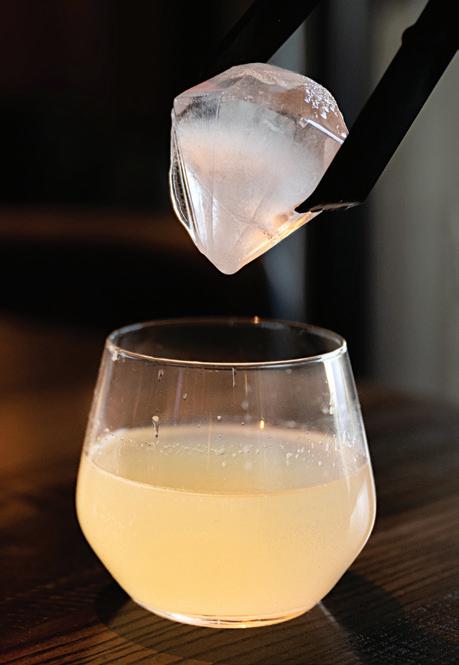
led onion, and chipotle aioli layered over a crispy tortilla.
With 13 restaurants across Texas, Florida, Georgia, Arkansas, Missouri, Minnesota, and Virginia, Cantina Laredo has found success in both suburban and downtown markets—and increasingly, in airports. Its newest opening at Atlanta’s Hartsfield-Jackson International Airport marks the brand’s third airport location, joining units at Dallas Fort Worth and Love Field. “We have been fortunate to partner
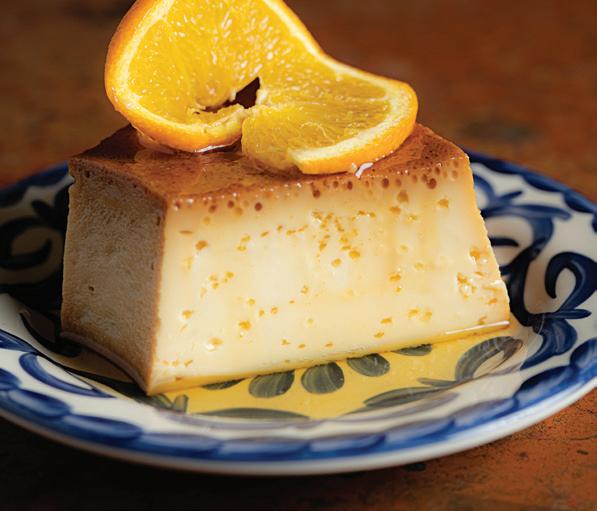
with experienced airport operators who don’t try and reinvent the wheel,” says president of franchise operations Mike Flippo. “They recognize the value of the Cantina Laredo brand and focus their management teams on executing the brand standards.”
From ahi tuna tacos to blood orange margaritas, the menu reflects Cantina Laredo’s philosophy of innovation and authenticity. “We’re always trying to focus on what the next cutting-edge flavor profile will be,” says Wierman. “We’re always trying to push the envelope on menu ideation.”
Moxies
VANCOUVER, B.C., CANADA
FOUNDED: 1986 UNITS: 57 (U.S. & CANADA)
Moxies, a Canadianborn restaurant chain, has been quietly making waves across North America. Spearheading this transformation is Joanne Forrester, a seasoned hospitality leader who spent two decades rising through the ranks at Boston Pizza before joining Moxies. Under her leadership, Moxies has evolved from its deli-style beginnings into a sophisticated, globally inspired restaurant with over 50 locations and plans for further expansion in major U.S. cities. Known for its progressive made-inhouse culinary offerings, innovative beverage program, and enlightened hospitality, Moxies is part of family-owned Northland Properties Corporation, which also owns two ski resorts, and over 175 restaurants and 66 hotels.

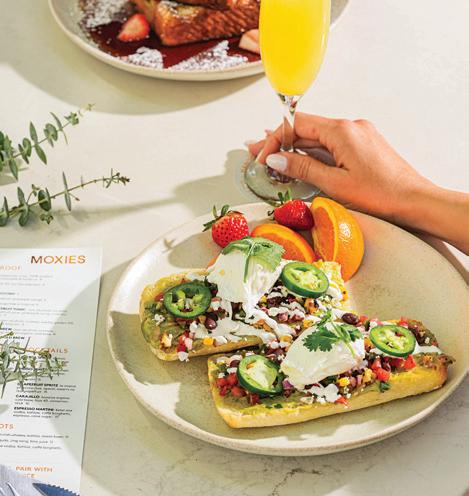

Fluffy Fluffy
TORONTO, ONTARIO, CANADA
UNITS:
40 (15 U.S.)
FOUNDED: 2018
A Canadian-based dessert chain serving up Japanese-style pancakes plans to be the next powerhouse to watch. Benson Lau founded Fuwa Fuwa —Japanese for “Fluffy Fluffy”—with a mission to deliver a dose of endorphins through a hybrid dessert café concept. The first Fluffy Fluffy location opened in Toronto, and in the five years since its inception, the brand has grown to nearly 40 locations across the U.K., Canada, China, France, and the U.S.
Batbox
ADDISON, TEXAS / MONTERREY, MEXICO
opened its first U.S. location in Addison, Texas—a 13,000-square-foot venue combining 10 immersive baseball simulators using proprietary software, with a full-service sports bar and elevated food and beverage program.
Broken Yolk Café
SAN DIEGO, CALIFORNIA
FOUNDED: 2018 UNITS: 41
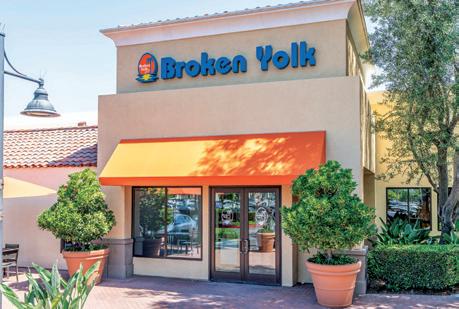
Red Phone Booth
ATLANTA, GEORGIA
FOUNDED: 2016 UNITS: 7
Red Phone Booth is a “time machine with modern standards,” according to founder Stephen de Haan. Inspired by his grandfather, a Prohibition-era pharmacist who “entertained like it was an art form,” de Haan built a concept that transports guests to the elegance and intrigue of the 1920s, centered around its hidden entrance through restored London red phone booths requiring a secret entry code.
“I wanted to build a place that treated classic cocktails with the same respect a great kitchen gives a foundational recipe,” de Haan says. “Red Phone Booth is my answer to a simple question: ‘What would an upscale members-forward speakeasy look like if you obsessed over every detail, the entry ritual, the glassware, the ice program, the air you breathe, without losing the warmth and joy of a night out?’”
nearby Buckhead. Since then, the concept has expanded its classy prestige to markets including Miami; Dallas, Texas; and Nashville, Tennessee. Under the guidance of parent company Roaring Franchises, the brand has also announced locations opening soon in Tampa, Florida, and Durham, North Carolina, which will mark seven total locations by the end of 2025.
Behind the curtain, Red Phone Booth operates like a high-end restaurant group with recipe books, prep lists, and air filtration systems that refresh the air in minutes. Its curated cocktail list features classics like the Smoked Old Fashioned and Aviation, alongside Italian small plates and Neapolitan-style pizzas.
As the concept expands nationwide from Atlanta to Dallas, de Haan notes it will stay selective, both in where they expand to and who they choose to partner with. “Growth is great, but the concept only works if it feels special. We are in this for the long run,” he adds.
The first Red Phone Booth location opened in 2016 in downtown Atlanta, followed by a second location in
FOUNDED: 2018 UNITS:
30 (1 U.S.)
Batbox is reimagining America’s pastime for a new generation. This fall, the Mexico-born social entertainment brand
Since opening its first café in Pacific Beach in 1979, Broken Yolk has built a loyal following for its hearty, scratchmade breakfasts, signature benedicts, and brunch cocktails. Now with 41 locations across the U.S., Broken Yolk Café is expanding beyond the West Coast into key markets via franchising.


FLUFFY FLUFFY

Atomic Cowboy
DENVER, COLORADO
FOUNDED: 2004 UNITS: 9
What started as a Denver dive bar has evolved into a one-of-a-kind restaurant trifecta. Founded by Drew Shader, Atomic Cowboy unites three powerhouse concepts— Fat Sully’s Pizza, Denver Biscuit Company, and a craft-focused bar—under one roof, serving guests from sunrise biscuits to late-night slices and pints. With locations in Colorado and Kansas City, the 18-hour-a-day hotspot has built a loyal following for its scratch-made comfort food, quirky Western-meets-retro design, and “simple perfection” philosophy.
Fat Patty’s
HUNTINGTON, WEST VIRGINIA
FOUNDED: 2007 UNITS: 6
With an AUV topping $2 million, Fat Patty’s is on the fast track to be -
coming the East Coast’s next great burger brand. Founded by Clint Artrip near Marshall University, the neighborhood bar and grill built its following on half-pound burgers, hearty appetizers, and a fun, community-driven atmosphere. Now franchising

under ARC Group, Fat Patty’s is expanding beyond its Appalachian roots into new markets like New Jersey, Wisconsin, and North Carolina. Led by CDO Sean Oatney, the brand’s huband-spoke growth model and second-generation build strategy offer franchisees a proven, profitable pathway—anchored by great food, cheeky hospitality, and hometown spirit.
KPOT Korean BBQ
EAST BRUNSWICK, NEW JERSEY
FOUNDED: 2018 UNITS: 100+
In just seven years, a New Jersey–based brand that blends Korean barbecue and an Asian all-youcan-eat hot pot experience has grown to more than 100 locations nationwide. Founded in 2018 by four friends under the umbrella of Vertex Hospitality, KPOT has rapidly become one of the country’s fastest-growing restaurant brands. Vice president Victor Chow attributes the meteoric rise to both timing and cultural openness. “America and Americans are open to something that’s a little bit more interesting than a decent burger or a sandwich place,” he previously told FSR At KPOT, diners order

and cook meats, vegetables, and soup bases tableside—turning dinner into a social event. Each 8,000-square-foot restaurant features a full-service bar, vibrant atmosphere, and buffet-style options, making the experience approachable for both seasoned fans and firsttimers. Staff act as “sherpas,” guiding guests through the process.
The concept’s success has also fueled opportunity. Most of KPOT’s locations are franchiseowned, and Chow says many franchisees are first-time business owners and immigrants, similar to his parents. “If I could help somebody achieve that American dream, become a boss of their own small business, and have it make decent money, I felt that I did something good for the day,” he says.
With expansion across 35 states and no signs of slowing down, KPOT is proving that the next frontier of full-service dining might just be bubbling right in front of guests—one hot pot at a time.

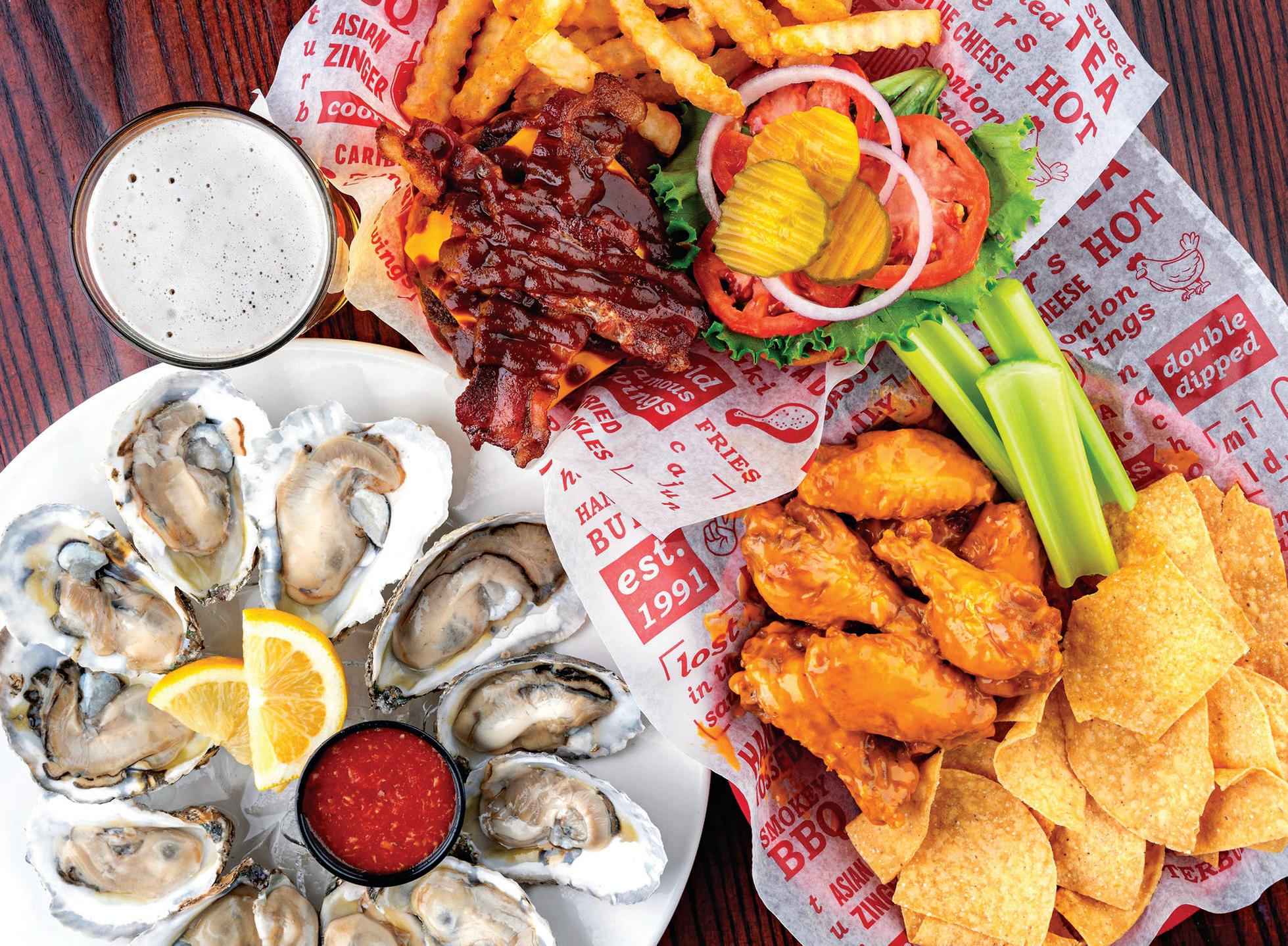
JEFFERSON’S
Jefferson’s
LAWRENCE,
KANSAS
Jefferson’s is proving that scaling a franchise doesn’t mean sacrificing its neighborhood soul. Founded in 1991 in Jacksonville, Alabama, the concept began as a college-town sports bar and grew into a full-fledged community gathering place known for its double-dipped wings, handpattied burgers, and fresh oysters.
President Brandon Graham, who rescued the brand’s flagship Lawrence, Kansas, restaurant from near-bankruptcy 15 years ago, now leads Jefferson’s expansion across the Mid-South while fiercely protecting its family-friendly, budget-conscious identity. “We have a leg up over the competition by being

a little bit smaller, more nimble, and involved heavily with franchisees and the communities that we operate in,” Graham says. “I think that’s part of the magic elixir of the wins that we achieve.”
Roughly 65 percent of Jefferson’s locations are owned by former employees—a testament to its people-first culture and grassroots growth. The brand’s new cooperative marketing fund empowers franchisees to invest in hyper-local outreach,
Los Dos Potrillos
CENTENNIAL, COLORADO
FOUNDED: 2002 UNITS: 6
Born from Jose Ramirez’s American dream, Los Dos Potrillos has grown from a single mom-and-pop restaurant into a thriving family-run brand led by his sons, Luis and Daniel. Known for its authentic Mexican cuisine and community-driven spirit, the Colorado-based concept now includes multiple full-service restaurants, a food truck fleet, and a new fast-casual prototype, Los Dos Potrillos Cocina y Cantina. With an in-house brewery, made-fromscratch recipes, and a future franchising model in the works, the Ramirez brothers are scaling their father’s legacy across Colorado—and beyond— while keeping one thing constant: heartfelt hospitality served with every plate and pint.
while an evolving menu keeps game-day favorites fresh and relevant.
As Jefferson’s eyes 100 locations within the next decade, its mission remains grounded in community. “At the end of the day,” Graham says, “we take very seriously the fact that we are selling one of the American Dreams of business ownership, and we want to make certain that we do the best we can to have those dreams fulfilled and be successful.”



PopStroke
JUPITER, FLORIDA
17+
FOUNDED: 2018
PopStroke is redefining the modern entertainment experience by fusing cutting-edge technology with an all-ages love of golf, dining, and fun. Founded by former Wall Street executive Greg Bartoli and backed by Tiger Woods’ TGR Ventures, the brand has grown more than 240 percent since January 2023, with 20 locations expected by year’s end and long-term goals of 150–200 venues nationwide.
Bartoli credits PopStroke’s success to its vertically integrated tech ecosystem. Through his company Heard Technology, he built a proprietary mobile app that powers nearly 80 percent of all transactions, allowing guests to keep score digitally, order food and drinks anywhere on property, and leave instant feedback managers can act on in

real time. “If you’re relying on 15 different thirdparty software systems, you’re stuck,” Bartoli says. “It’s really enabled us to unlock a long road.”
Each PopStroke blends world-class putting courses with a fullservice restaurant and bar—soon to be branded Bar Tenders—serving scratch-made fare, craft cocktails, and ice cream. New prototypes, including a cold-weather venue in Nashville, will accelerate expansion into untapped markets like Chicago, New York, and Denver. As Bartoli puts it, PopStroke is “building an experience that resonates with everybody”— from families and kids to date-night crowds and golf enthusiasts alike.
Novecento
MIAMI, FLORIDA
FOUNDED: 1991 UNITS: 6
A South Florida icon with roots in Buenos Aires, Novecento has been reimagined for a new generation under SuViche Hospitality Group. Founded by the late Hector Rolotti in 1991, the beloved Argentinian bistro remains true to its heritage of premium steaks, handmade pastas, and warm hospitality— now enhanced by modern design and technology-forward operations. CEO Aliosha Stern has led the brand’s evolution with updated interiors, streamlined systems, and refreshed menus that balance authenticity with innovation. From its renovated Brickell flagship featuring a dry-aging room and speakeasy bar to new stadium locations, Novecento continues to embody timeless Argentine culture with contemporary flair.

The Post Chicken & Beer
BOULDER, COLORADO
FOUNDED: 2013 UNITS: 5
Founded by Dave and Dana Query of Big Red F Restaurant Group, The Post Chicken and Beer has become a Colorado institution by perfecting the art of crispy, gluten-free fried chicken and pairing it with awardwinning craft beer. What started in Lafayette has grown to five locations across the Front Range, each offering a cozy, mountain-lodge vibe and a menu that celebrates comfort classics

NOVECENTO
like meatloaf, chicken pot pie, and hatch chile mac and cheese. With head brewer Nick Tedeschi leading a lineup of medal-winning beers, The Post continues to bring together craft and comfort, earning loyal fans along the way.
Pacific Table
SAN FRANCISCO, CALIFORNIA
FOUNDED: 2003 UNITS: 15
For over two decades, Pacific Catch has blended culinary adventure with a mission of ocean-friendly dining. Founded by Keith Cox and Aaron Noveshen,
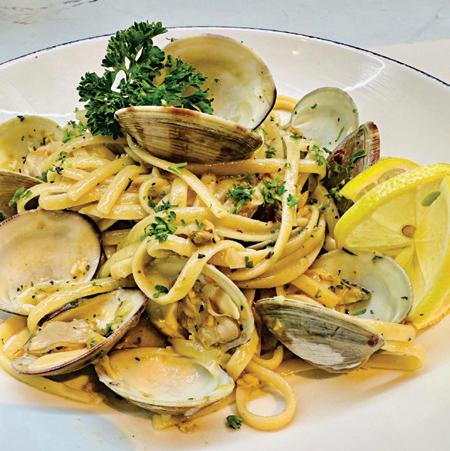
the Bay Area–based fish house celebrates the flavors of the Pacific Rim through responsibly sourced seafood and a laid-back, island-inspired experience. From Ahi Poke Bombs to Yellowtail Sushi Tacos, the menu balances innovation with sustainability. Now with 15 locations across California—including Santa Monica, Tustin, Campbell, and La Jolla—the brand remains anchored in its commitment to ethical sourcing through partnerships with the Surfrider
Foundation, Seafood Watch, and Smart Catch, proving that mindful dining can be both craveable and sustainable.

Top Burmese
PORTLAND, OREGON
FOUNDED: 2019 UNITS: 4
What began as a small delivery concept has blossomed into one of Portland’s most distinctive full-service restaurant groups. Founded by husband-and-wife duo Kalvin and Poe
Myint, Top Burmese celebrates the flavors of their homeland with authentic dishes like tea leaf salad, hand-mixed curries, and street-style appetizers that reflect Burma’s blend of Indian, Thai, and Chinese influences. The Myints’ journey—from an early food cart to four thriving brick-and-mortar locations—embodies their philosophy of passion and authenticity first, business second. As they prepare for expansion to cities like Seattle and the Bay Area, Top Burmese continues to introduce diners to the warmth and depth of Burmese hospitality.
Sunny Street Café
COLUMBUS, OHIO
UNITS: 22
FOUNDED: 2007
For Sunny Street Café, the secret to growth is simple: Lead with heart, hospitality, and homestyle food. Founded by Mike Stasko Sr. in 2007 and now led by his son, Mike Stasko Jr., the Columbus-based breakfast-and-lunch brand has doubled down on its mission to serve communities with warmth and authenticity—while positioning itself to outpace legacy all-day breakfast chains.
“Brunch offers people a lifestyle or experience they typically can’t find in the restaurant industry,” says Stasko Jr. “Remaining in this segment was crucial to us and became ingrained in our brand culture.”
With 22 restaurants across Ohio, Missouri, and Texas, Sunny Street Café has achieved double-digit sales growth for two consecutive years, driven by its scratch-
made menu and strong off-premises business. Breakfast favorites like Banana Bread Oatmeal, Migas Breakfast Tacos, and Homemade Corned Beef Hash—paired with brunch cocktails like the Palm Fizz—anchor a menu designed to feel both comforting and fresh.
Stasko credits Sunny Street’s success to its people-first philosophy. “We positioned ourselves during the pandemic to take care of our people because we knew our customers would come for their service and smiles,” he says. Now, as the brand prepares for its next growth phase, franchising will fuel expansion into new markets across the Southeast and beyond—without compromising its core mantra: family-owned, peopledriven, and here to stay.
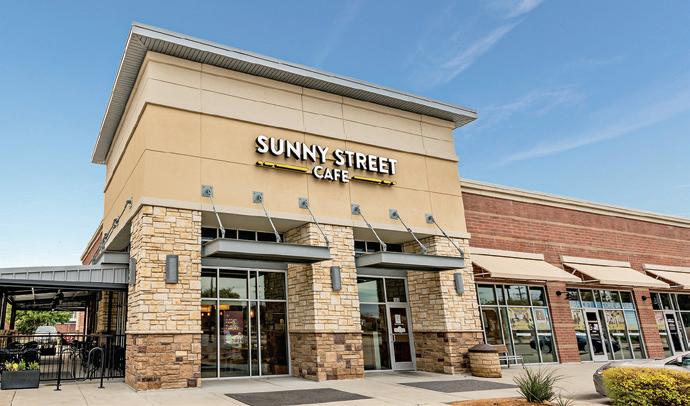

Urban Egg
COLORADO SPRINGS, COLORADO
UNITS: 11
FOUNDED: 2012
Born in Colorado and built on scratch-made cooking, local sourcing, and heartfelt hospitality, Urban Egg continues to rise as one of the region’s most beloved breakfast brands. Founded by Randy Price in 2012, the concept has expanded across Colorado, Texas, and Kansas, with six more slated for 2026. The newest restaurant in downtown Denver showcases Urban Egg’s next-generation design with bright interiors, a lively bar, and a guest “wishing wall.” Its menu celebrates morning comfort food with creative flair—from Huevos Rancheros and Billion $$$ Bourbon Bacon to the signature Gourmet Pancake Flight. Led by CEO Mark Augarten, Urban Egg stays true to its roots by supporting local suppliers and giving back through community partnerships like Food For Thought Denver—proving growth and good will can go hand in hand.


Breakfast Republic
FOUNDED: 2015 UNITS: 16
Celebrating its 10-year anniversary this year, Breakfast Republic has evolved from a scrappy San Diego startup into a rising NextGen Casual concept that has grown to the double digits. Founder and CEO Johan Engman started his hospitality career as a dishwasher after immigrating from Sweden. One key decision for Engman was to make the cuisine unmistakable in the name of his new concept.
Breakfast Republic—a nod to the Golden State’s original moniker, the California Republic—left no doubt about what was on the menu. “Hence, with a name like Breakfast Republic, it’s pretty hard to think we’re an Italian steakhouse,” he quips.
At the time in San Diego, Engman says, “When I looked around at breakfast places [near the first location of Breakfast

Republic], it was kinda all the same—booths, tables, chairs, sugar caddies. There was no effort, I thought. So I wanted to put a lot of emphasis on standing out.”
Known for its quirky interiors, tongue-in-cheek merchandise, and playful menu, the concept has become a staple of San Diego’s brunch scene. Favorites include the Jurassic Pork Benedict, Pineapple Upside Down Pancakes, and Mr. Presley French Toast—alongside an inventive cocktail lineup featuring bacontopped Bloody Marys and guava mimosas.
Breakfast Republic now anchors Engman’s Rise & Shine Hospitality Group, which operates 23 restaurants
under multiple morningfocused brands. Despite its growth, Engman has remained fiercely independent—eschewing private equity to preserve quality, ethics, and a people-first culture. The brand sources locally, uses pasture-raised eggs, composts food waste, and donates $1 from designated menu items to community nonprofits.
From humble beginnings to a 16-unit powerhouse, Breakfast Republic embodies the new wave of socially conscious, creatively driven breakfast dining. With eyes set on future expansion, Engman continues to prove that passion, integrity, and a good cup of coffee can take a local favorite national.
SAN DIEGO, CALIFORNIA


















Women in Leadership BY SATYNE DONER
Growing Through the Generations With Grumpy’s
After nearly three decades, Margie Murphy passes the torch as Grumpy’s next generation of leaders proves its family-first culture is the key to its staying power.
MARGIE MURPHY wasn’t looking for a job—she had already retired from the restaurant world in 2002—but her deep ties to the Jacksonville, Florida, community led her to Grumpy’s. She hasn’t looked back since. The award-winning franchise has become more than just a workplace; for Murphy, it feels like home.
“There’s no place like Grumpy’s,” Murphy says. “I’ve raised my family here, I’ve met generations of customers and staff, I’ve celebrated all sorts of special occasions with our team, and managed a lot of long-time friendships. We’ve always been more than just a restaurant.”
Since 1999, Grumpy’s Restaurant has sought to bring dining back to its roots as a traditional Americana diner, becoming a beloved neighborhood spot with five locations. In an increasingly competitive full-service dining landscape, Grumpy’s has prioritized both employee satisfaction and the guest experience—not as extras, but as foundations for success.
Murphy’s story is a testament to those values, which emphasize worklife balance, real growth paths, and high retention rates fueled by the brand’s culture of belonging and family. She started as a server 23 years ago and worked her way up to manager, now holding the title


“Queen of Grumpy’s,” given to her by a group of loyal customers.
“When I first started, we had maybe 10 employees total, and we’ve all had to learn to grow and lead through the changes,” Murphy says. “But the one thing that never changed is the heart of Grumpy’s. The trust I’ve built over the years with our community and management team is so special to me.”
Two occasions stand out to Murphy as examples of the brand’s role as a cornerstone of Northeast Florida’s dining
community: once during a hurricane, and another during the pandemic.
“We lost electricity, and trees had fallen all over,” Murphy says. “But the Orange Park customers came in and helped us clean tables, serve food, and get us back in order. Our commitment to the community was reciprocated tenfold.”
During COVID-19, Grumpy’s president and CEO Daniel DeLeon gave up his own salary to support employees through closures, maintaining a 100 percent retention rate throughout the pandemic. He instructed teams to set up produce stands in restaurants for customers and organized meal deliveries to the neighborhood.
After nearly three decades of dedicated service, Murphy will retire for
COURTNEY SMITH, MARGIE MURPHY, AND ANGELA “ANGIE” BROWN HAVE ALL LED “VERY DIFFERENT LIFE PATHS, BUT WE ALL STARTED FROM THE BOTTOM AND PROVED THAT ... AS LONG AS YOU STAY FOCUSED AND TRUE TO YOURSELF, YOU CAN SUCCEED,” MURPHY SAYS.
Women in Restaurant Leadership

SINCE 1999,
GRUMPY’S RESTAURANT HAS SOUGHT TO BRING DINING BACK TO ITS ROOTS AS A TRADITIONAL AMERICANA DINER, BECOMING A BELOVED NEIGHBORHOOD SPOT WITH FIVE LOCATIONS.
good on December 31, 2025, embarking on a new chapter. Throughout her career with Grumpy’s, she says she’s proud to be the “Queen” and grateful for the opportunity to raise her family and provide for her child’s college education. She’s passing the torch to Courtney Smith and Angela “Angie” Brown, who have also grown with Grumpy’s.
Smith started as a server in 2018 and now serves as vice president of operations, guiding the growth of the franchise. From day one, she felt supported professionally and personally by DeLeon and his wife, Morgan, whom she served with for a while before rising through the ranks.
“We build from the bottom and try to expand from within. I wanted to do more for the company … and I had [the DeLeon’s] full support. We’re all here grinding together, leading by example,” Smith says. “They taught me the power of consistency and how to invest in others. Our team sees that, and it makes them want to stay with us and help us scale.”
For the small but steadily growing franchise, Smith has mastered the art of balancing business growth with preserving the family feel that makes Grumpy’s unique. As an operations leader, she encourages a hands-on approach to leadership, creating an open-door communication policy for employees.
“We want everyone to feel connected
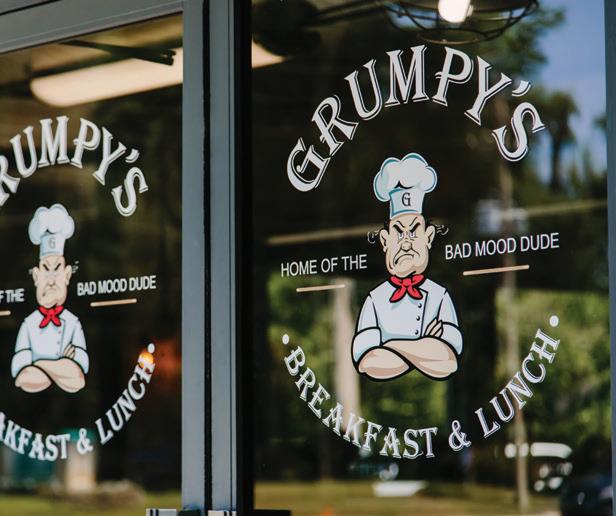
and valued, no matter how big we become. Whether it’s business or personal, we’re always available,” Smith says. “We’re keeping our minds open to different ideas and contributions. Our stories show the team that they can pursue leadership in this industry.”
enjoys mentoring her team, paying it forward, and helping others reach their own goals. She says she enjoys knowing she can have a positive impact—not just on the guest experience, but also in the careers and lives of the people she works alongside.
“The secret is starting from a place of genuine care, from remembering names and favorite orders to asking about life updates and milestones,” Brown says.
“Our regulars don’t just come for the food. They come here for the relationships and consistency. We know how to command a kitchen and inspire a team, creating a

safe, high-performing environment. It’s the hallmark of Grumpy’s success.”
Like Smith, Brown also joined the Grumpy’s family in 2018 as a host. Smith, Murphy, and the rest of the team have been with her through each milestone in her personal life, celebrating the wins and working through challenges together.
“I was a stay-at-home mom for 12 years before starting here, and I was able to get a solid foundation in hospitality as a host before being encouraged to take on new responsibilities and leadership roles. Each step gave me a chance to grow my skills and confidence,” Brown says. “This kind of environment is rare, and it makes coming to work every day meaningful and fulfilling.”
Now, as assistant general manager of the Orange Park location, Brown
For the seventh consecutive year, Grumpy’s has been named “Best Restaurant Overall” in the 2025 Best of Bold City Community’s Choice Awards, presented by The Florida Times-Union and Jacksonville.com. The brand took home five coveted titles, ranging from “Best Breakfast” to “Best Locally Owned Business,” proving that when you invest in people, the rest takes care of itself. Even as it continues to seek franchise partners across Florida and Georgia, its smalltown diner feel remains.
“The three of us [Murphy, Smith, Brown] have very different life paths, but we all started from the bottom and proved that no matter what you do, as long as you stay focused and true to yourself, you can succeed,” Murphy says.
“Through the years, we’ve cried together, we’ve laughed together, and created a family in these four walls. And that’s what keeps us at Grumpy’s.”
GRUMPY’S (3)
BY TALLULAH HAWLEY
Elm Street Diner’s Recipe for Viral Success

HQ: Stamford, CT
FOUNDED: 1987
UNITS: 2
FOUNDERS: Angelo and Helen Moshos
CUISINE: Elevated American Brunch
The growing brunch haven has amassed nearly 700k followers across social media with its viral stacked waffle towers and loaded pancake tacos— but it hasn’t sacrificed quality along the way.
JOHN MOSHOS HAD A VISION for Elm Street Diner—one that would make it stand out not only among locals as a neighborhood favorite, but also as a buzzy brunch concept with viral visuals to drive national attention and potential for expansion. Moshos’ parents—Greek immigrants Angelo and Helen Moshos— opened the casual diner in Stamford, Connecticut, in 1987. Moshos and his sister, Stella, grew up helping out with the family business from the beginning, cleaning tables and assisting servers.
“[My parents’] dream was that their kids went to college and did something different,” Moshos says. He studied economics and business at New York University and began his career at a financial brokerage firm on Wall Street. But after 9/11, Moshos says, the landscape of the finance industry changed dramatically, and he decided to return to the family business. “I wanted to help grow the business, and, much to everyone’s surprise, I did,” Moshos says. “I had a vision of a place that we ran as our own.”
Fast forward to 2013, Elm Street Diner had become a popular local restaurant, yet he still saw room for improvement. As his parents contemplated
ELM STREET DINER’S MENU INCLUDES JOHN MOSHOS’ OWN FUNKY CONCOCTIONS, BUT ALSO THE GREEK CLASSICS THAT THE RESTAURANT HAS BEEN SERVING SINCE DAY ONE.
On the Rise
retirement, co-owners Moshos and his sister, Stella—who manages brand, community, and sponsored events—strove to rebrand the diner to add some fun and uniqueness to differentiate itself in the Stamford food scene.
“I pushed the rebrand to make us not just an everyday place but a really cool, fun, outgoing place where we can draw a lot of younger people and families, and have brunch and daytime become more mainstream, and turn us into a destination,” Moshos says. “And with our social media over the years, Elm Street has really exploded now.”
The 38-year-old family-owned diner has garnered nearly 400,000 Instagram followers, 200,000 on TikTok, and 80,000 on Facebook. “It’s funny, I’d been taking pictures and videos of food many years ago, and people would look at me like I was strange. I was making different things, like different milkshakes in all different kinds of flavors and other unique, out-of-the-box things,” Moshos says.
“In the beginning, we served all these Greek favorites like spanikopita, souvlaki, moussaka, and this really delicious rice pudding,” he continues. “Those were all great and really fit the older clientele demographic, but as time evolved, the next generation has been exposed through social media to all these new flavors and different palates, and different types of foods.”
Elm Street Diner has a hulking menu that includes regional cuisine, brunch specialties, and Moshos’ own funky concoctions, but also the Greek classics that the restaurant has been serving since day one. “It wasn’t really ‘cool’ for a 21-year-old to go to a diner on a Sunday,” he says. “We’ve turned it into, not like a party, but a brunch atmosphere, and we’re the destination for the weekend.”
The menu is constantly changing, either with limited-time offers or seasonal switch-ups, but Elm Street Diner’s social media presence has led some guests to order a meal by showing a specific post to their server. Moshos says that social media interactions also help him gauge the popularity of items before they hit the menu.

WITH YEARS OF HARD WORK MANAGING, MARKETING, AND CURATING THE DINER OF HIS DREAMS, THE BRAND’S ORGANIC DIGITAL GROWTH IS A LABOR OF LOVE FOR CO-OWNER JOHN MOSHOS.
He even added a new section to the menu labeled “Social Media Superstars,” featuring stacked flavor mashups like the Churro Pancakes Brunch Burrito (punctured by a syringe of hot honey) and the Sweet & Savory Brunch Pancake Tacos stuffed with bacon, fried chicken, and a churro waffle. “I’ve always loved classic, elevated American diner food, and having those everyday things you grew up on, but putting a twist on it,” Moshos says.
“With social media, there’s inspiration out there for everything, but you can take one thing from something you saw,” he says. “Like [you can add] mozzarella sticks to grilled cheese, and make it extra cheesy, but then we take it an extra step further and add freshly breaded chicken breast and homemade vodka sauce, and that crazy sandwich is now one of our best sellers, the Chicken Cutlet Vodka Mozzarella Melt.”
Elm Street Diner also offers a multitude of layered milkshake combinations, topped with cake, candy, and sprinkles. A weekly milkshake special is launched every Monday, a recent example being the super-sweet Elm Street Cake Shake with a frosting-dipped rim and stacked with unique cake or cupcake options, frosting, and candy piled to the ceiling.
“I didn’t want to always just serve blueberry pancakes,” he says, “because why would somebody drive an hour to me and pass a bunch of other restaurants just for blueberry pancakes?”
Before opening the brand’s second location last year in Norwalk, Connecticut, Moshos contemplated going by just ‘Elm Street’ since the brand is no longer simply a diner per se, but he wanted to maintain the nostalgia by keeping the
original name that his parents chose. Despite the virality and rising popularity of the brand, Moshos still manages the brand’s social media himself. Through his own creations, his personality shines through. For example, Moshos is a die-hard Lakers fan (and was at Kobe Bryant’s last ever game). Because Bryant was born a few years before Moshos, he saw the basketball star’s rise to fame as a great inspiration growing up. On the menu now is the Black Mamba burger, a double burger with bacon, grilled onions, chipotle aioli, and five onion rings, an ode to Bryant’s championship rings.
Being in the restaurant industry for so long, Moshos says that actively using social media has elevated his restaurant to a new level. “I can reach so many people in so many places at once that I would’ve never had the chance to do back in the day with a phonebook or word-of-mouth in the neighborhood,” he says. “Now, we’ve made regular customers of people who have to drive one, two, three, or four hours away.”
Leveraging analytics, Moshos can see the brand reaches people all over the world. “I’ve been stopped in airports wearing our merch; I’m in Greece this summer, and people have come up to me saying that they’ve seen our videos,” he adds. “That could never be done without social media; the reach is impossible.”
The brand’s second location in Norwalk is located just eight miles away from the original Stamford store. Moshos plans to open another location in Connecticut and then continue growing into other states. “It’ll be a bit, but we are definitely interested in moving to other markets,” Moshos says. “The end goal was never to be just a neighborhood place,” he adds. “I’ve made so many interactions and relationships through social media, I’d love to open in another country.”
With years of hard work managing, marketing, and curating the diner of his dreams, the brand’s organic digital growth is a labor of love. “[The online traction] generates into actual in-person visits and not just clicks and follows— it can turn an everyday business into a brand,” he adds.
Advertising Index
Boursin
handhelds.boursin.com
Ghirardelli
888-402-6262 | ghirardelli.com/professional
Idaho Potato Commission
208-334-2350 | idahopotato.com
J&J Snack Foods
jjsnackfoodservice.com/request-free-samples
Johnsonville Foodservice
Johnsonvillefoodservice.com
KPS Global
682-317-5341 | kpsglobal.com
Monin 18, 19 monin.com
NorthAmerican Bancard 3 866-481-4604 | NYNAB.com
North Country Smokehouse
NCSmokehouse.com
Progressive Commercial
888-806-9598 | ProgressiveCommercial.com
Stratas Foods
888-404-1004 | stratasfoods.com Vito Fryfilter
847-859-0398 | vitofryfilter.com
& LIVESTOCK AUSTRALIA FLIP SUPPLEMENT
Meat & Livestock Australia . . . . . flip inside front cover, 1-10, flip back cover foodservice.aussiebeefandlamb.com
Advertising Inquiries
Eugene Drezner
VP, BUSINESS DEVELOPMENT edrezner@wtwhmedia.com | (919) 945-0705
Amber Dobsovic
NATIONAL SALES DIRECTOR adobsovic@wtwhmedia.com | (757) 637-8673 Edward Richards
NATIONAL SALES DIRECTOR erichards@wtwhmedia.com | (216) 956-6636
Tom Boyles
NATIONAL SALES MANAGER tboyles@wtwhmedia.com | (662) 607-5249



Behind the Scenes

JOHN HAGGAI ROLE: CEO
BRAND:
Burtons Grill & Bar
LOCATIONS: 23
FOUNDED: 2005
HQ: Andover, MA
From washing dishes at Outback Steakhouse at age 18 to leading a 20-year-old full-service brand into its next chapter, John Haggai has built his career on one core belief: Success starts with great people, high standards, and operational excellence. Haggai joined Burtons Grill & Bar in 2020 with a clear mission— to grow the brand without compromising its soul.
Haggai breaks down Burtons’ evolution, how “everyday excellence” fuels consistency across locations, how the brand’s recent refresh is deepening guest relationships, and why team development remains the heartbeat of Burtons’ long-term vision.
BY CALLIE EVERGREEN


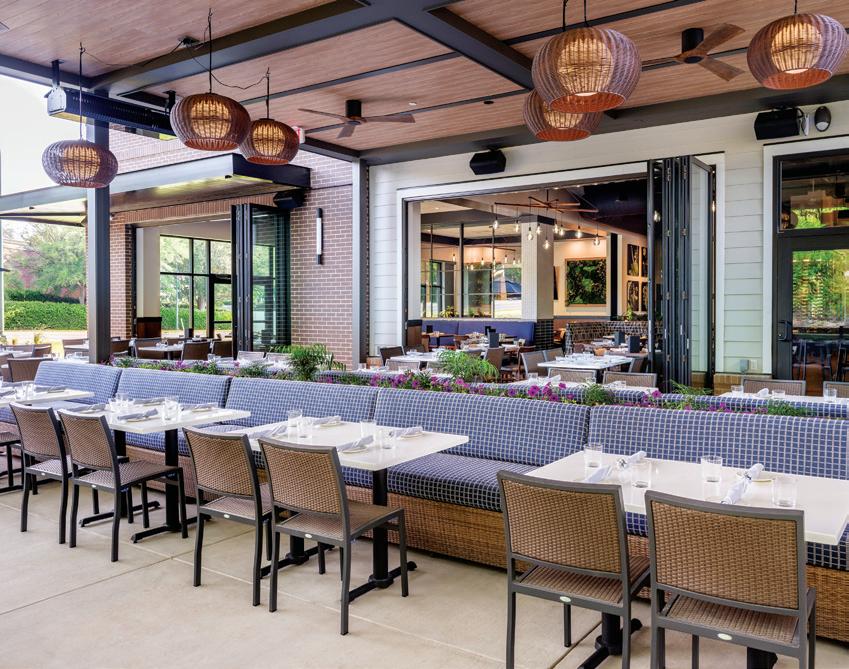
Embodying Everyday Excellence
How do you ensure “everyday excellence” is upheld across your growing concept?
“Everyday Excellence” isn’t a tagline, it’s our operating system. It starts with our people and touches every aspect of the business. We’ve created a high-performance culture grounded in what we believe are industryleading standards, accountability for outcomes, and continuous feedback. That keeps us focused on what matters most and ensures consistency in execution, especially during times of growth.
Walk us through your recent brand refresh?
If you don’t continually grow and evolve, you get stagnant. We refreshed the brand because we wanted it to reflect who we are now. We launched a new website to meet our guests where they are in the customer journey and, ultimately, make it easier to engage and covert. Our reimagined Burtons Rewards program builds off the success of our email marketing program and creates new opportunities for our guests. We see these platforms as an extension of our hospitality.
What’s the key to retaining top talent in this industry?
We create an environment where great people are valued, developed, and recognized. Clear career paths, autonomy to run their restaurants, and respect for work-life balance all matter. Most of all, we fiercely protect our culture and our people. A+ players attract other A+ players, and that creates an unstoppable environment where everyone is pushed to be their best.
What’s the secret to your staying power?
Evolving and adapting without ever losing our core or the trust that got us here. The path forward is simple: Stay true to our values, empower our teams, and keep our heads down to do the work. I believe in disciplined, methodical growth—scaling responsibly while staying rooted in our values. The future is about creating opportunities for our people and memorable experiences for our guests. As long as we remain anchored in great people, high standards, and consistent execution, our runway is long and our future is bright.
TWISTS ON AMERICAN CLASSICS
MENUING WAGYU
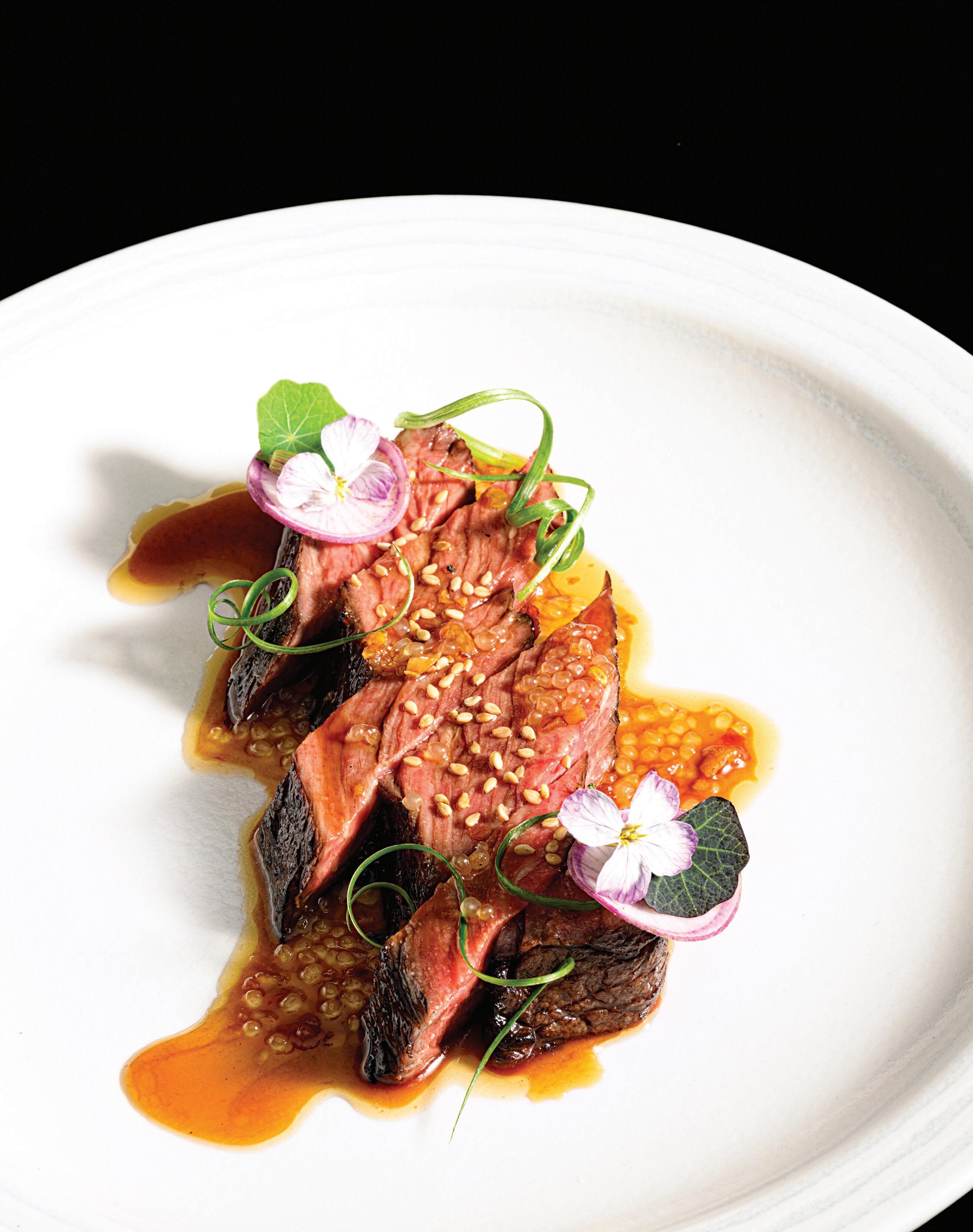
CHEF INSIGHTS
VERSATILITY OF GRASSFED BEEF
PASTURE TO PLATE
BEHIND THE BEST MAC & CHEESE IN BOSTON
AUSTRALIAN RED MEAT.
ATTRACTING GEN Z TO FUEL RESTAURANT GROWTH +
OYSTER BLADE TATAKI



Making Wagyu a Menu Mainstay
BY ABBY WINTERBURN
IN THE WORLD OF PREMIUM MEATS,
few names carry as much weight as Wagyu—and Australian Wagyu has quickly become a standout choice for chefs and restaurant operators looking to elevate their menus without sacrificing value. Known for its exceptional marbling, flavor, and versatility, Australian Wagyu strikes the balance between indulgence and accessibility, delivering unforgettable meals for guests while supporting profitability for the operator.
Organizations like Aussie Beef & Lamb have been instrumental in helping chefs and operators better understand the potential of Australian Wagyu. By providing—at zero cost—resources, education, and guidance on how to properly source and handle premium beef, they ensure culinary professionals have the confidence to incorporate Wagyu into approachable formats that balance both value and profitability.
This support has helped fuel Wagyu’s rise in professional kitchens around the world. Renowned chefs and the world's top steakhouses have long turned to Wagyu for its unmatched richness and depth of flavor, and Australian Wagyu has steadily earned a place in their kitchens. One such chef is Benjamin Udave, whose culinary journey reflects the values that make Wagyu so special.
Udave is one of the leading team

members of ThinkCulinary, a master distributor of world-class craft proteins. “We take pride in the fact that we are a chef-owned company,” Udave says. He emphasizes their chef-driven approach, working only with brands they’d proudly serve while supporting sustainability for future generations.
Restaurant operators are increasingly making premium meats, like Australian Wagyu, more approachable and cost effective for guests.
“What we’ve found is that most of our customers only need a 6–8 ounce portion, and once we teach them to approach Australian Wagyu the same way they would Japanese A5—by selling it by the ounce—it becomes far more approachable for the customer,” Udave says. “That format makes guests feel more comfortable ordering it, and operators more confident featuring it on their menus.”
As a further example, Chef Udave demonstrates how a less celebrated cut of Wagyu can shine in featured dishes. “We took Mayura Station top round—a cut often dismissed as
tough and lean—and turned it into three approachable menu items: breakfast steaks, Milanese, and tartare,” Udave says. “By fabricating it properly, operators can menu a fullblood Wagyu breakfast steak that could cost them under $10 a portion, while still allowing them to charge a premium. It proves that “outside the middle” cuts of Wagyu can deliver incredible value and profitability.”
Wagyu is everywhere, and restaurant operators are seeing opportunities to be even more creative and innovative. Looking forward, Udave sees opportunity in value-added products like Wagyu charcuterie and ready-to-cook items that make the beef even more versatile.
With the support of organizations like Aussie Beef & Lamb, chefs and operators have the tools and confidence to make Australian Wagyu both approachable and profitable. By pairing premium quality with education and innovation, they’re helping the next generation of restaurants deliver unforgettable dining experiences built on the very best beef. ❖

The Secret Ingredient for Restaurant Growth
Unlocking the power of premium protein.
BY ABBY WINTERBURN
TODAY’S DINERS —especially younger demographics—are seeking meals that deliver both value and an elevated eating experience. Premium red meat has emerged as a powerful differentiator, allowing restaurant operators to move beyond commodity offerings and position themselves as destinations for indulgence, flavor, and quality.
According to Meat & Livestock Australia (mla), production reached record levels in fiscal year 2025, underscoring Australia’s ability to deliver a reliable, large-scale supply of premium red meat. Much of this supply comes from grass fed, pasture-raised systems, aligning with the growing consumer demand for proteins that emphasize natural production, authenticity, and wellness.
From the consumer side, Datassen-
Meet the Chefs
Leading chefs with firsthand experience with Australian red meat production share stories, insights, and dishes that showcase Australia’s commitment to quality,

tial research shows diners are increas ingly seeking upscale meat experiences and are willing to pay more for grass fed and high-quality options. Nearly half of consumers say they would pay more when menus highlight sourcing and product integrity, reflecting the value they place on transparency and premium protein offerings.
Fully trimmed, premium red meats from Australia offer solutions tailored for full-service needs—from full primals to portion-controlled cuts and value-added products crafted for high-volume kitchens—delivering flavor without sacrificing efficiency. With a robust supply chain and a global reputation for quality, Australian proteins empower operators to innovate confidently and tap into rising demand for premium offerings.
By incorporating Aussie Beef & Lamb, full-service restaurant brands can stand out in a competitive landscape, strengthen customer loyalty, and drive profitability—proving that premium doesn’t have to be out of reach for fast, convenient dining.
Chef Stephen Toevs

Chef Stephen Toevs, senior director of culinary for Marriott International, is a seasoned luxury dining expert and an Aussie Beef Mate. A Marriott veteran for nearly 30 years, he has opened over 15 Ritz-Carlton properties and is a competitive BBQ champ.
“When I went to Australia to see beef production up close, you could see how happy and beautiful those animals were, and how much pride the farmers took in them. That shows through all the way to the plate. In hospitality, the ability to tell a story and work with ingredients that have integrity and provenance is increasingly important. We can serve Aussie beef with confidence, and that’s a win.”
CHILI ROASTED FLAT IRON STEAK WITH JALAPENO CHIMICHURRI BUTTER
Chef Ashfer Biju

Executive chef and director of food and beverage at New York’s Baccarat Hotel, Chef Ashfer Biju brings global expertise shaped by his upbringing in India and decades of international experience. Known for blending tradition with innovation, he curates refined dining experiences that embody the hotel’s luxury and set a new standard in culinary excellence.
“Australia is so ahead in sustainability and transparency; it’s just built into how production is done. They went to great lengths to show us every aspect of what they do, from animal welfare to sanitation, and halal. Now I can serve with confidence and tell those stories to my guests, and that’s powerful.”
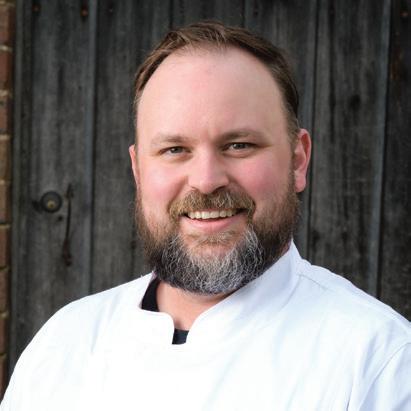

AUSTRALIAN LAMB SHANK WITH POTATOES AND ROOT VEGETABLES
Chef David Godsoe
Chef David Godsoe is culinary director for Ottawa’s Eighteen Hospitality Group, a leading multi-concept operator in Canada’s capital city. A passionate advocate for sustainable, high-quality meats, he is one of Aussie Beef & Lamb’s newest Lambassadors, bringing creativity and expertise to every dish he creates.
“Aussie lamb has been a staple on my menus for years! First off, it is incredibly consistent in quality and tenderness, which is crucial to restaurants. Flavor-wise, it has a milder, more subtle flavor that my guests appreciate.”
Chef Ian Ramirez of Mad Honey Culinary Studio recently travelled to Queensland as part of a global delegation of Aussie Beef Mate chefs, exploring the region’s rich food and culture.
“It’s hard to appreciate the scale of beef production in Australia until you see it—the vast grazing land, the transparency across the supply chain, and the pride in world-leading practices. I was especially impressed by the focus on animal welfare and the natural, stress-free lifestyle of the cattle.”
AUSTRALIAN WAGYU BEEF TATAKI

SEARED


Chef James “JP” Patterson


Chef James “JP” Patterson is the corporate executive chef for McConnell Golf Properties and food & beverage director at Porters Neck Country Club. Known for his upscale take on local bounty, his cuisine celebrates flavor, creativity, and refined Southern hospitality.
“My team and our club members followed along as I traveled Down Under to experience Aussie Beef & Lamb firsthand. They are hungry for the stories and to see what ideas I’m bringing back to them. I’m workshopping an Aussie lamb slider bar idea to see what builds and toppings guests go for. It’s delicious!” ❖
AUSSIE LAMB
WITH SPRING VEGETABLES AND HERBS OF PROVENCE
Chef Ian Ramirez
DOUBLE COOKED LAMB KOFTE AND GRILLED VEGETABLES



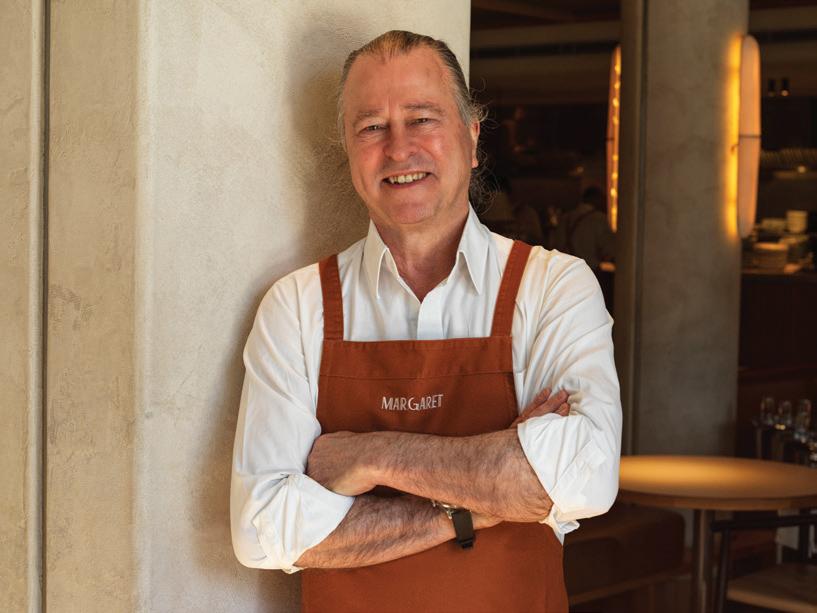

Capturing Gen Z’s Attention on Menus
BY YA’EL M c LOUD
CAPTURING GEN Z’S ATTENTION is not just a perk—it’s a necessity as they make up a growing share of restaurant spending. One defining feature of this generation is their interest in ethically sourced food—choices that benefit both the planet and their personal health. In fact, 63 percent of Gen Z are willing to spend more on food that is ethically sourced and produced, according to Attest.
This comes as no surprise to chef, registered dietitian, and nutritionist Pam Smith, who has built her career around creating craveable, healthy, and sustainable dishes.
“Flavor is what everyone is after, but I also want dishes to be nutritious and sustainable,” Smith says. “That’s what led me to work with Aussie Beef & Lamb—it sits at the intersection of health, wellness, sustainability, flavor, and versatility.”
Grass-fed beef, in particular, represents a growth opportunity for menus. It works operationally in the back of house and connects with Gen Z values in the front of house.
“Early on, I used grass-fed beef because of its leanness,” Smith explains. “Now, chefs are choosing it for broader reasons: sustainability, provenance, and guest trust. Grassfed beef from Australia is raised on pasture and most often without antibiotics or growth hormones, on lands unsuitable for other uses. The result is clean, flavorful protein with incredible depth of taste that comes from diet rather than fat.”
Taste still wins at the end of the day, but consumers—especially Gen Z— want flavor they can trust to be nutritionally dense and ethically sourced. Aussie Beef and Lamb has become a widely trusted partner in kitchens and on menus to deliver just that.
“Gen Z is the first generation to truly merge personal health with planetary health,” Smith says. “They care about where food comes from and its environmental impact.”
Smith adds that grass-fed beef carries a natural “health halo”—consumers intuitively perceive it as better for them. That halo is supported by its nutritional benefits and by operational advantages. “From a culinary perspective, grass-fed beef is versatile and cooks quickly, making it ideal for both commercial and home kitchens,” she says.
For full-service operators, Aussie grassfed beef offers more than a protein—it offers a story. By calling out provenance and sustainability on menus, restaurants can connect with Gen Z diners who want transparency and purpose in their dining choices. Pairing grassfed beef with global flavors, seasonal produce, or creative small plates gives operators a way to stand apart, while building a reputation for quality that today’s consumers are eager to share.
The opportunity is clear. Gen Z’s purchasing power is projected to reach $360 billion in disposable income, according to Bloomberg, and their dining choices are shaped by values as much as taste. “I tend to think of grass-fed beef and lamb as almost a blank canvas—you can use it in any global cuisine with any flavor system,” Smith says. Aussie Beef & Lamb delivers on that promise, offering trusted provenance, consistent flavor, and proven sustainability. For full-service restaurants, it’s a reliable way to capture Gen Z’s attention—while serving flavors every generation craves ❖
ISLAND GRASSFED STRIP STEAK SIZZLE STICKS

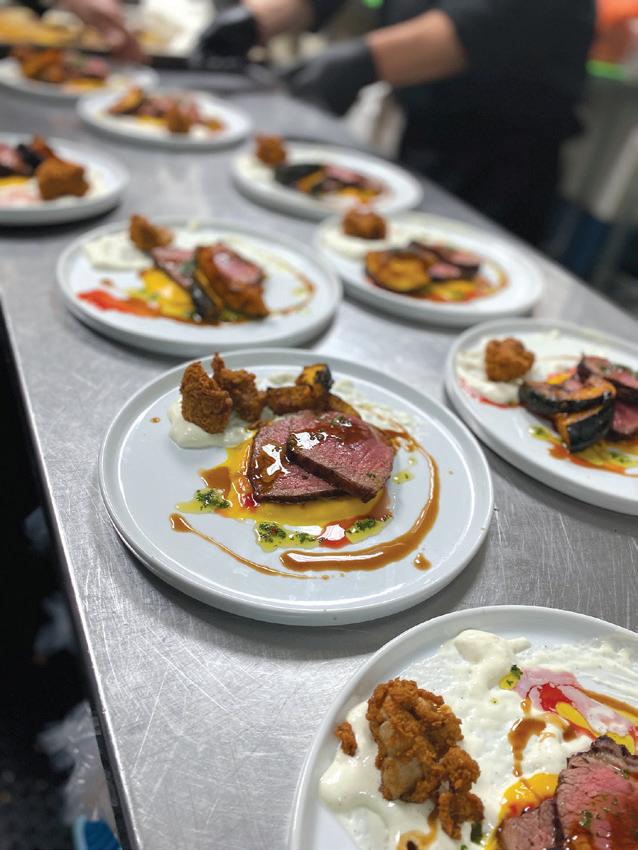


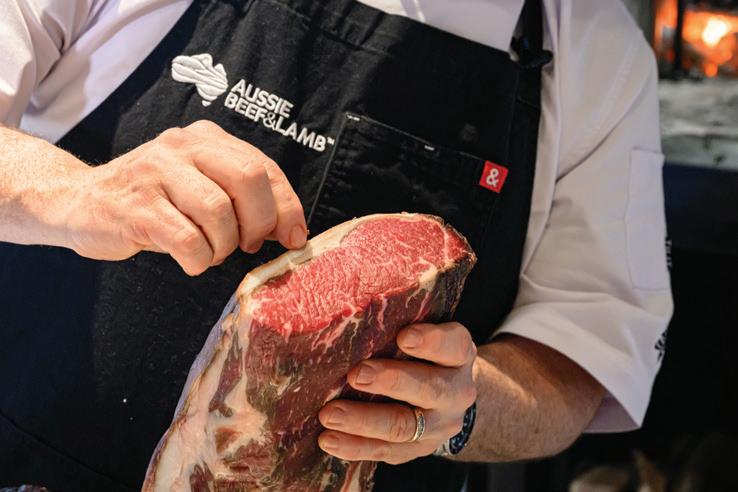




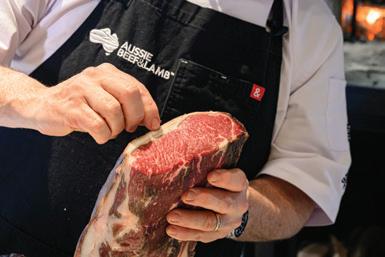


What Makes the Best Mac and Cheese in Boston?
How a Chopped Grand Champion thinks about innovation with this underused protein.
BY YA’EL M c LOUD
CHEF SABA WAHID DUFFY, a Chopped Grand Champion, is well known in the culinary world, yet she never expected mac and cheese to be the dish she would be known for. But when Boston Magazine named her lamb merguez–topped mac and cheese one of the best in the city, that is exactly what happened.
This success is especially notable considering lamb’s relatively low menu penetration in the U.S. and consumers’ general hesitance toward the protein. According to Menu Matters, in 2025, only 19 percent of operators were menuing lamb. Yet with growing consumer interest, there is an opportunity for lamb to gain more traction compared to other proteins.
“I think some people just aren’t familiar with lamb,” says Chef Saba Wahid Duffy, Aussie lambassador and owner/operator of Kush Modern Mediterranean in Somerville, Massachusetts. “When it’s done right, it’s flavorful and enjoyable. Lamb is a flavorful, rich, and fatty meat, which is often why it is seen as a more luxurious menu item.
Dishes like lamb merguez are now gaining popularity, as the warm North African spices combined with the richness of lamb create craveable flavors consumers increasingly seek


out. Duffy’s lamb merguez mac and cheese shows how lamb can find a place on menus at lower price points in approachable, familiar formats.
Duffy emphasizes the importance of high-quality, sustainable sources, which is why she relies on Aussie Beef & Lamb. “I had the opportunity to visit Australia and see the pastures myself—it showed me how much passion goes into raising the animals,” Duffy says. All Australian lamb exports are exclusively grass-fed, resulting in a more flavorful product that consumers can feel good about. Additionally, all of Aussie Beef & Lamb’s lamb is halal, which Duffy views as a significant benefit. “I have a pretty diverse customer base, but because I grew up in the Muslim community, people look to me to have a
halal option. I can confidently say we serve halal protein because I trust the source.”
As global flavors continue to shape American dining, lamb is poised for growth. Younger diners in particular are eager for bold, international flavors, and approachable formats like Duffy’s mac and cheese prove that lamb doesn’t have to remain a luxury protein. “Be adventurous when it comes to lamb,” Duffy says. “Good quality lamb doesn’t need a lot—but you can elevate it, experiment with it, and create something unique.”
For operators, the lesson is clear: pairing trusted, familiar dishes with lamb lowers barriers to trial, while sourcing reliable product, like Australian lamb, ensures quality and consumer confidence. “It really comes down to how you season and cook it—you need to know how to treat lamb,” Duffy says. When done right, lamb has the potential to move from niche indulgence to a versatile staple on modern menus. ❖
LAMB MERGUEZ
CHEF SABA WAHID DUFFY


